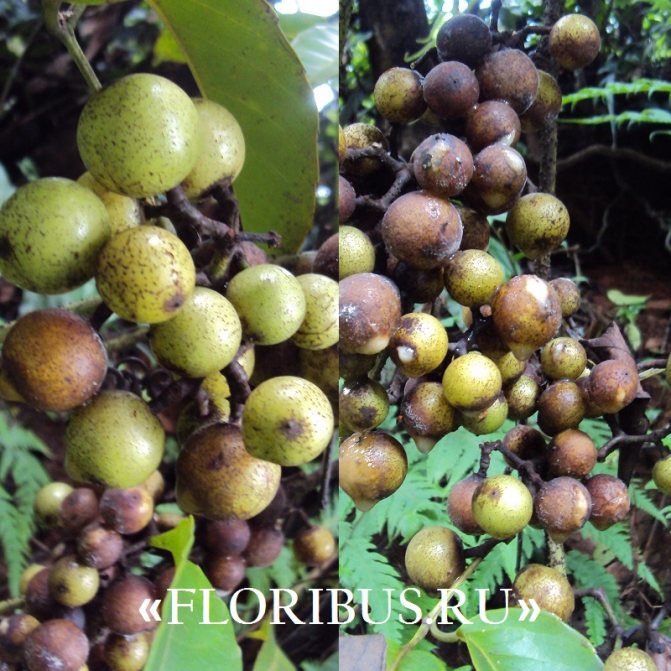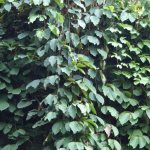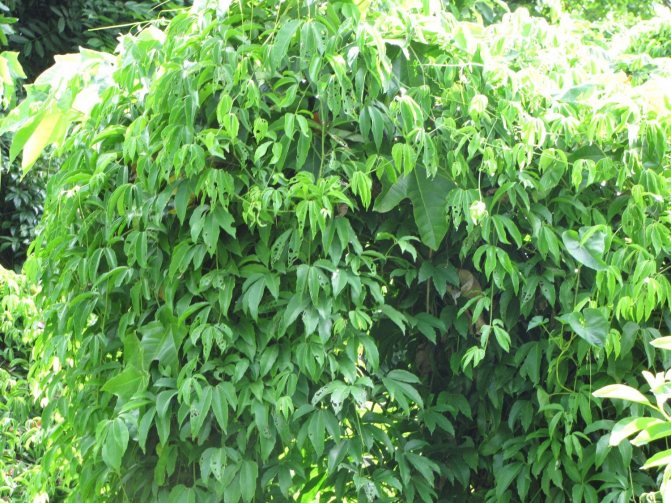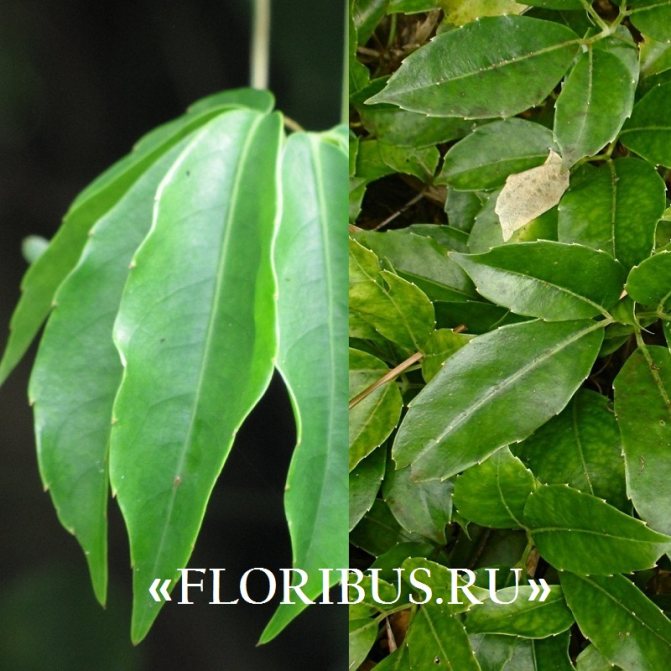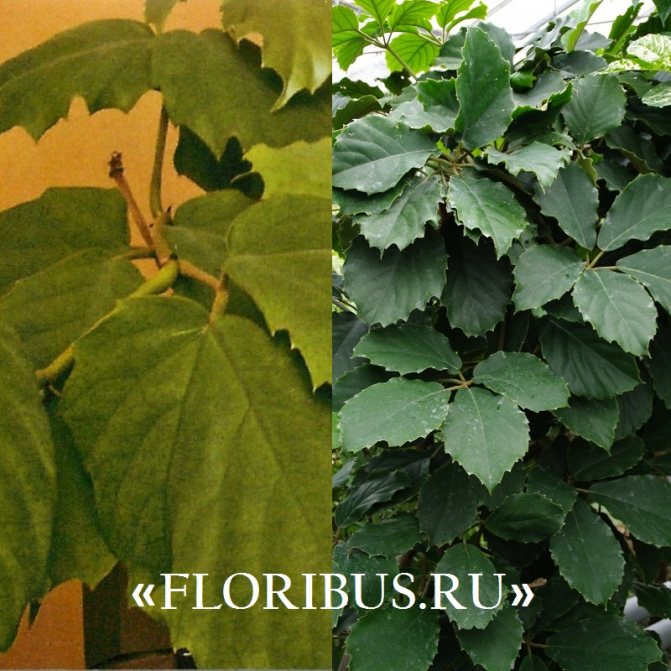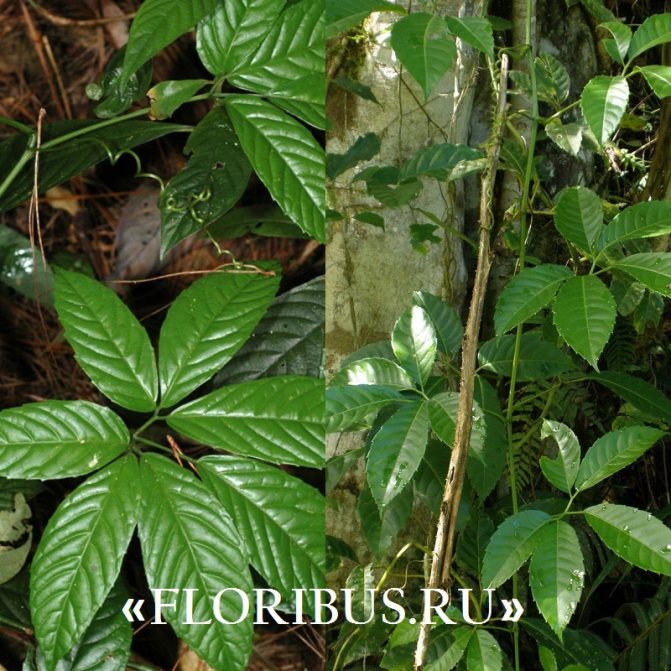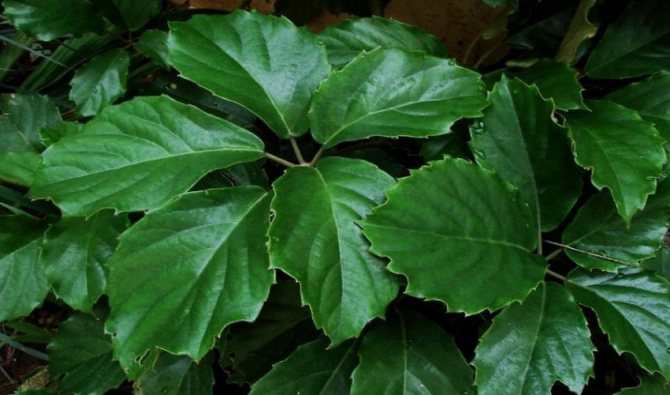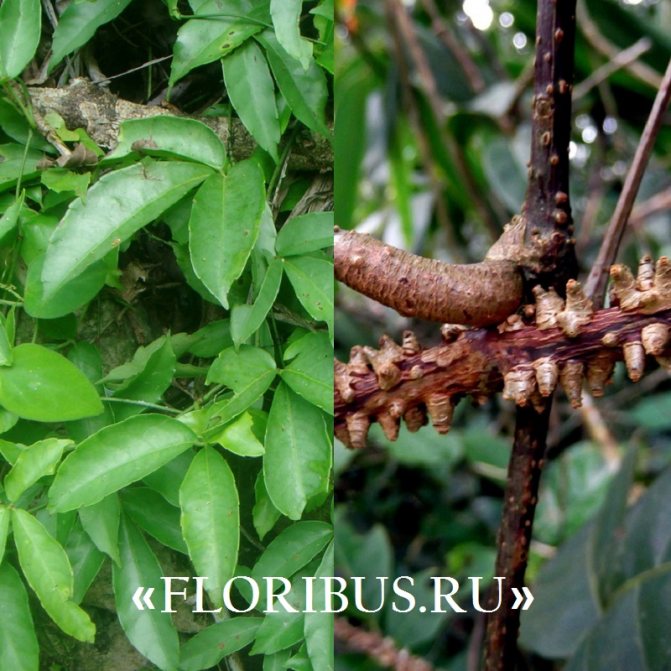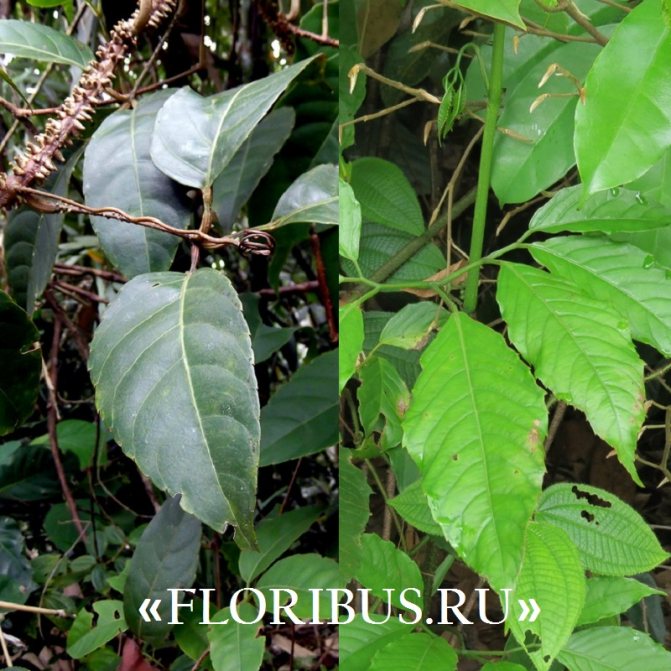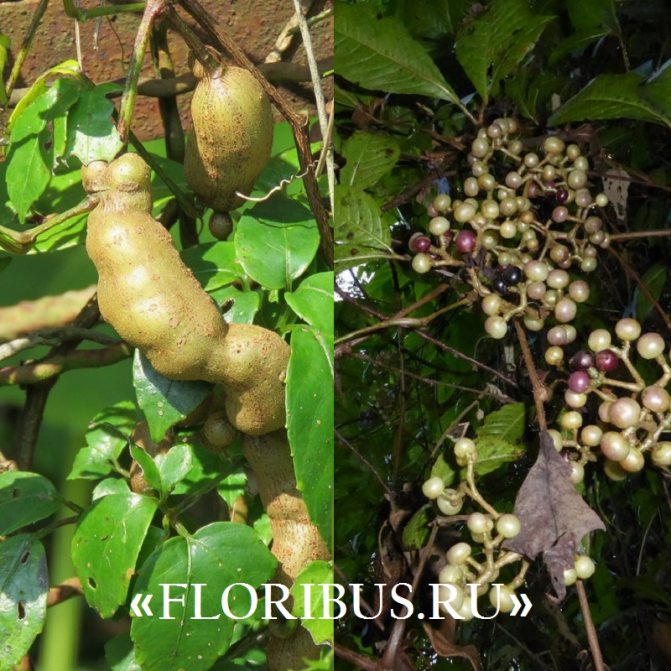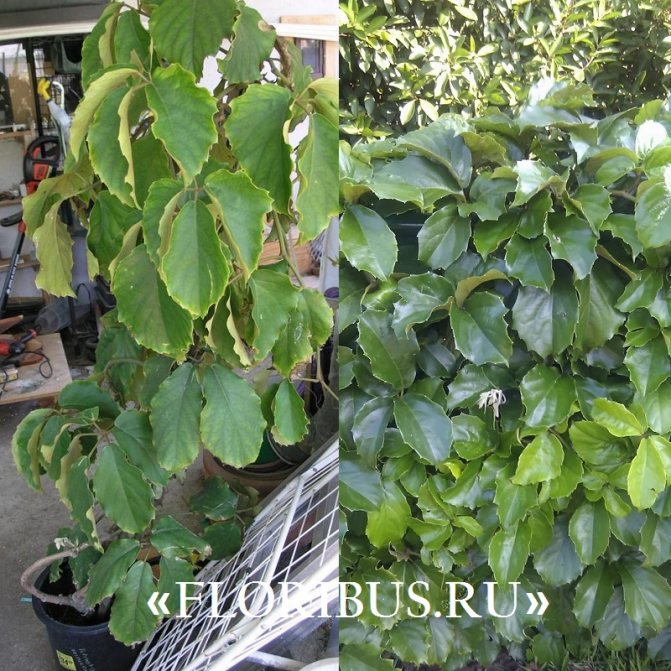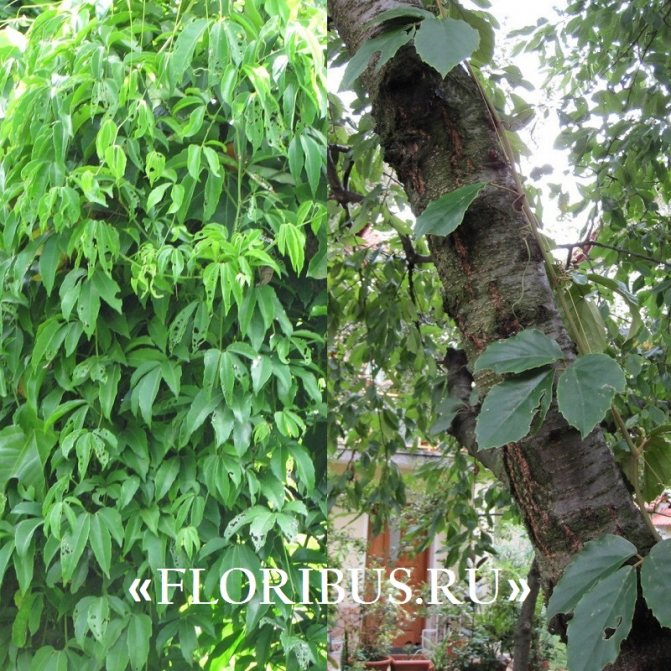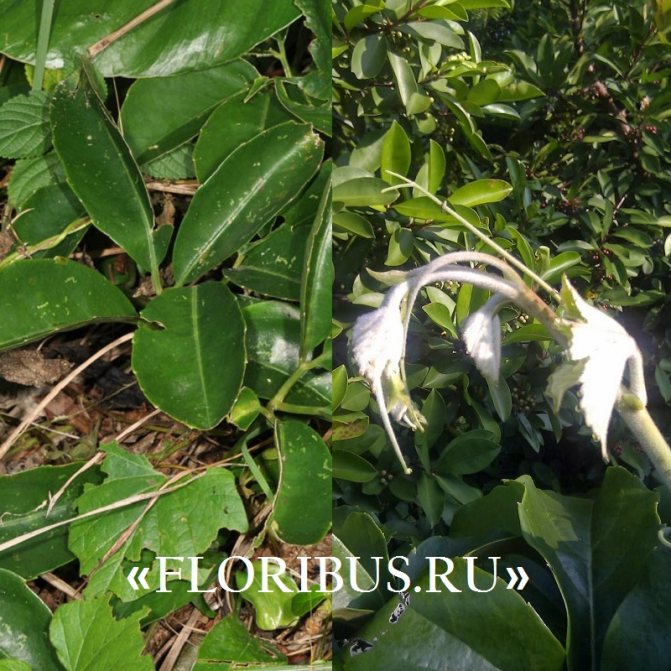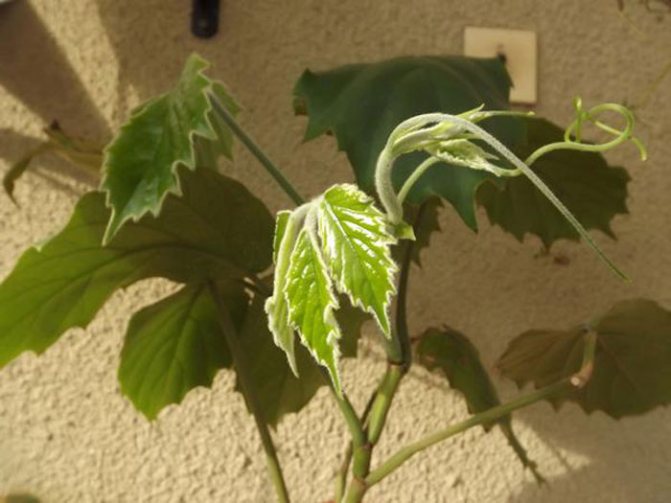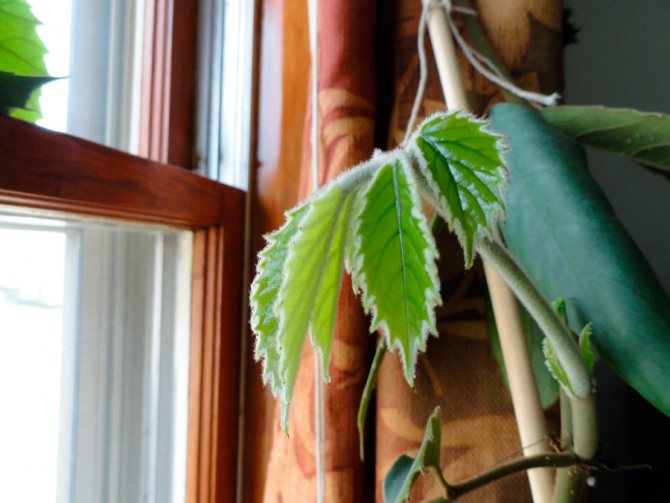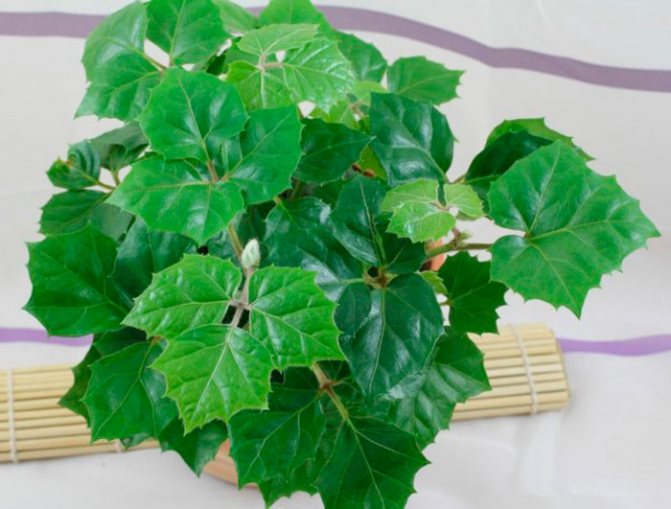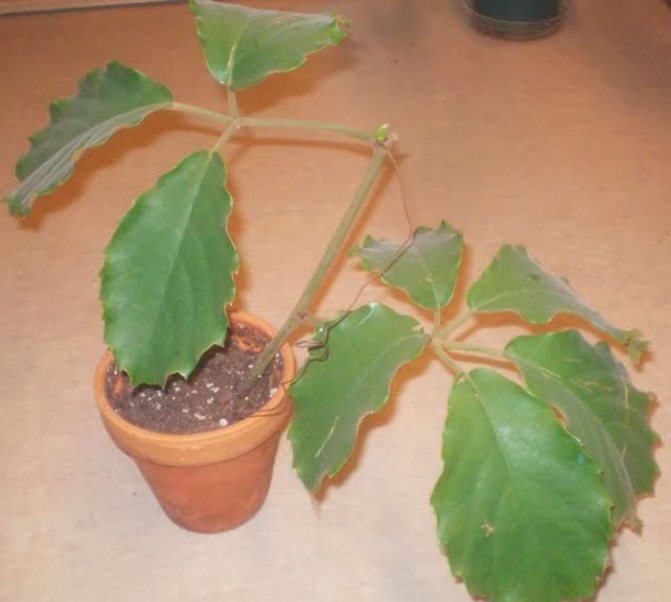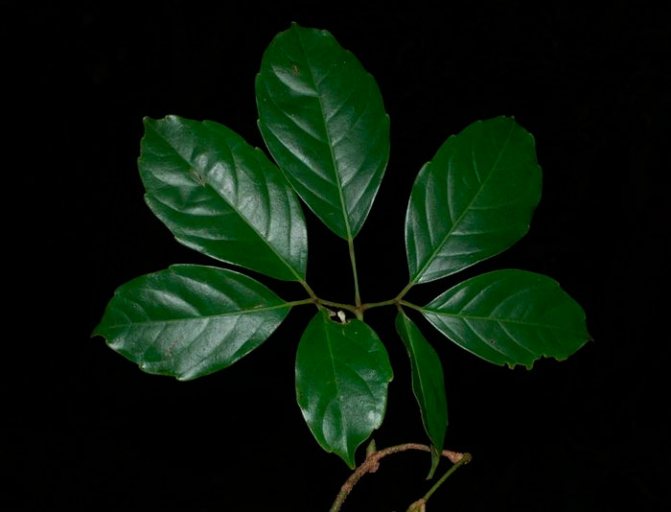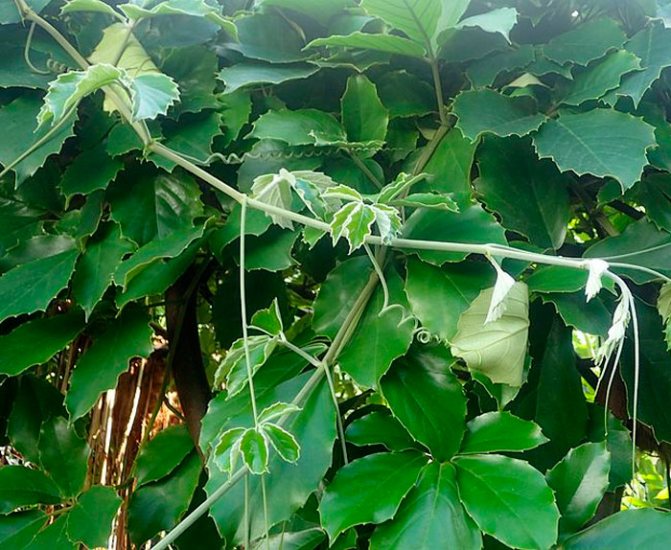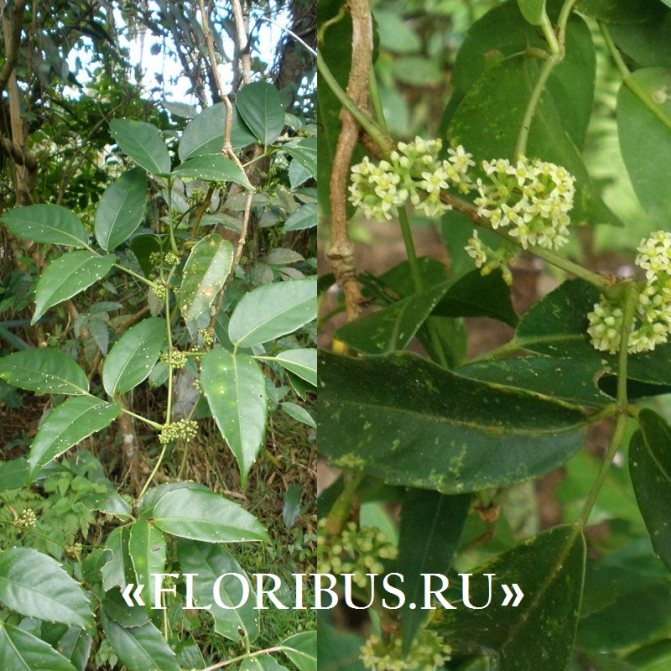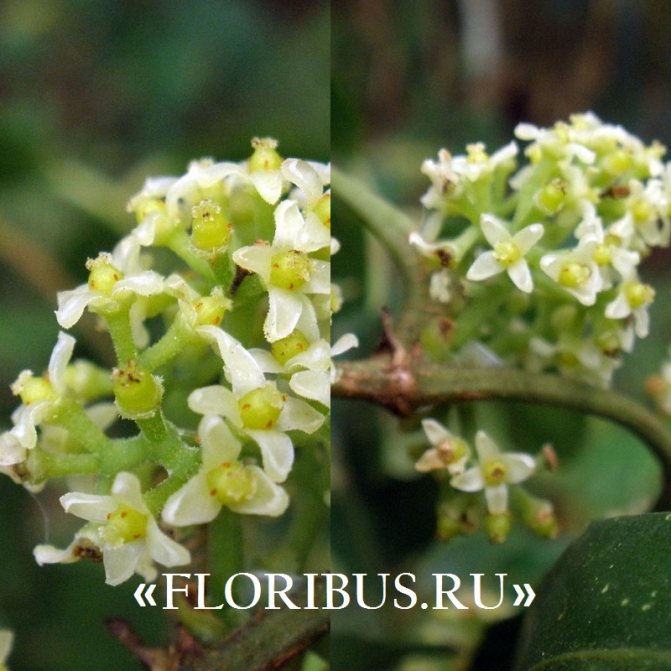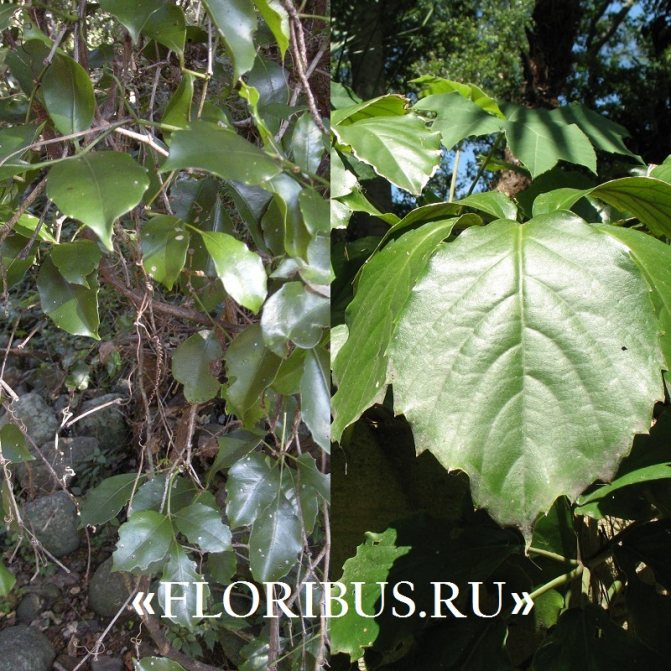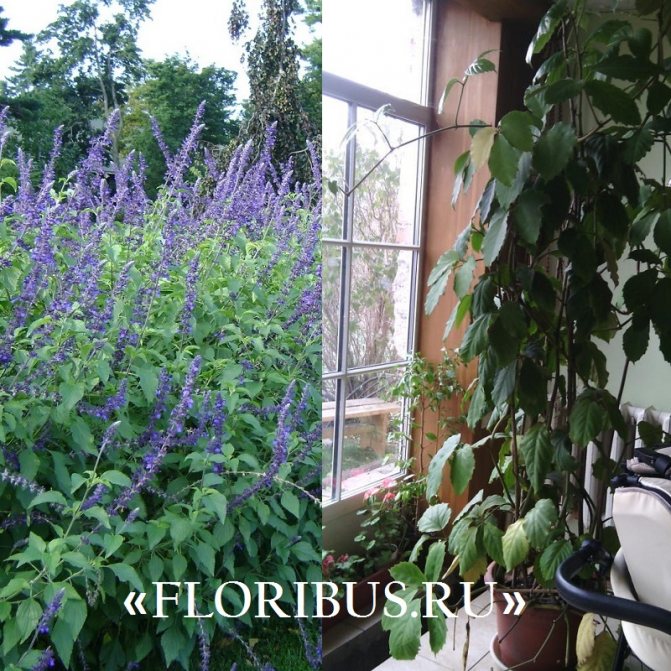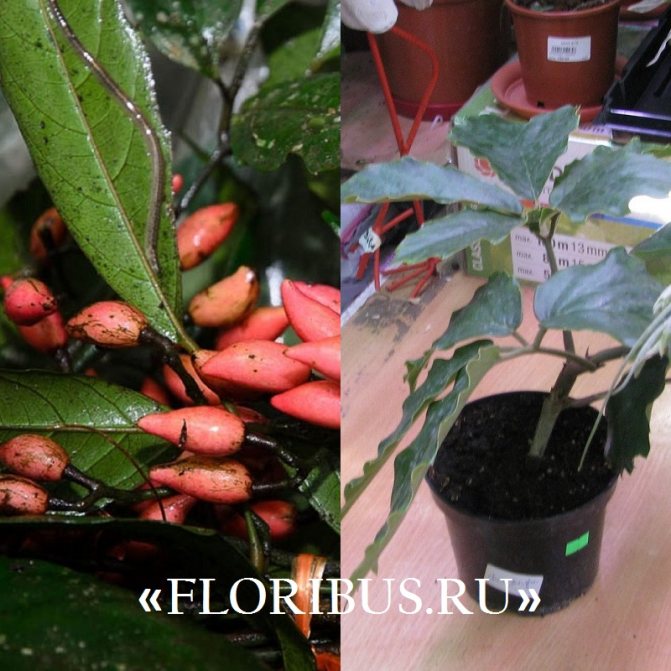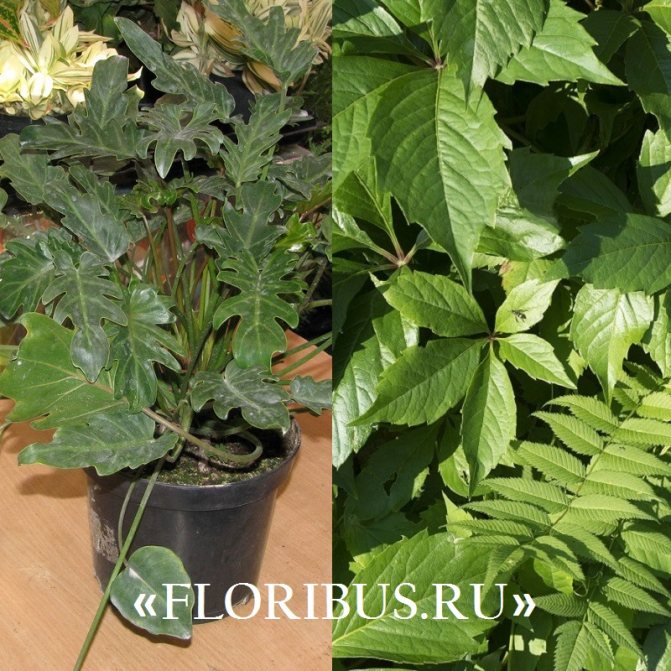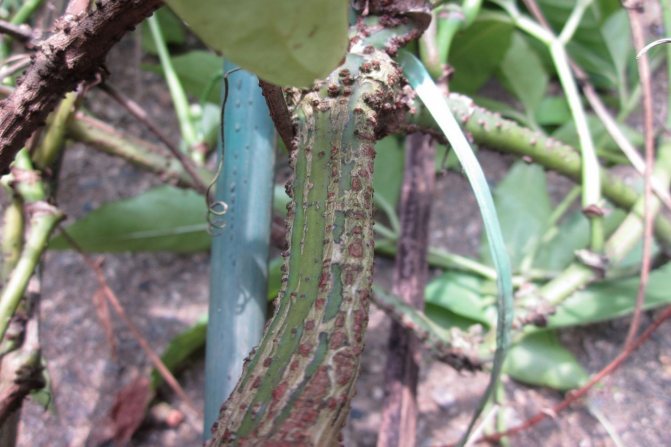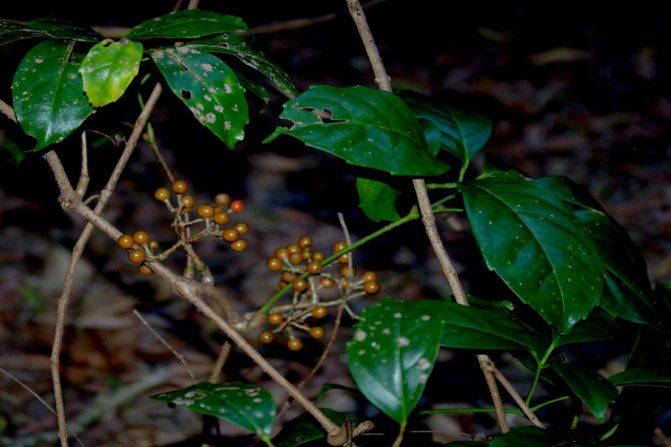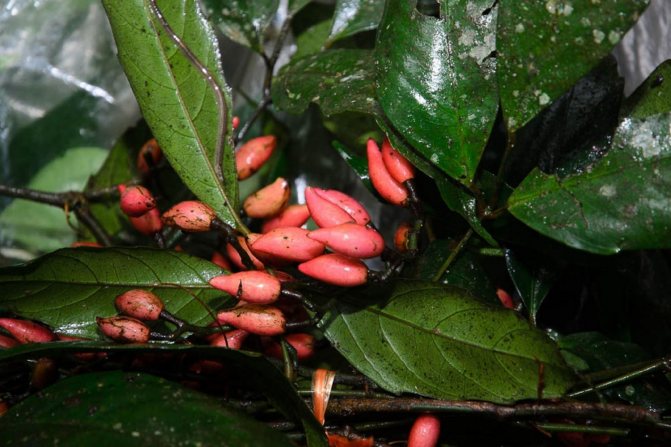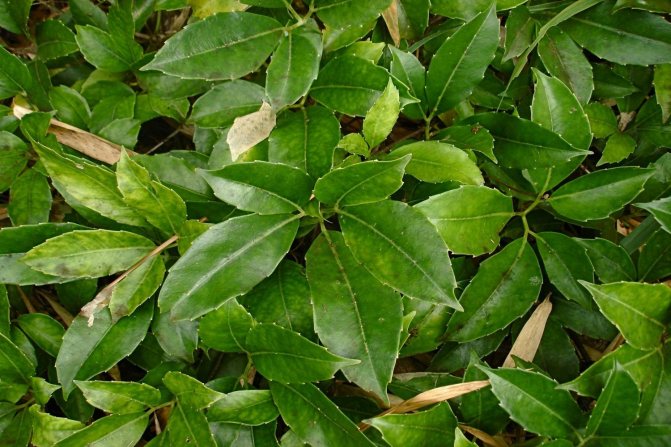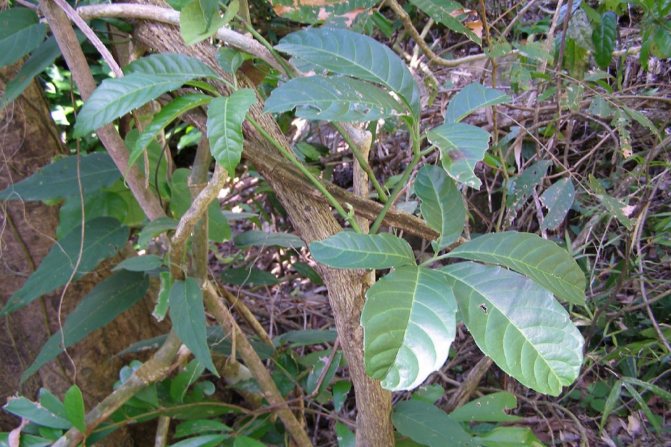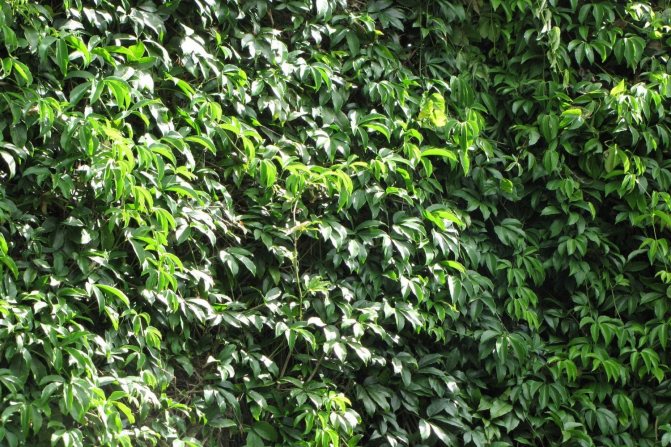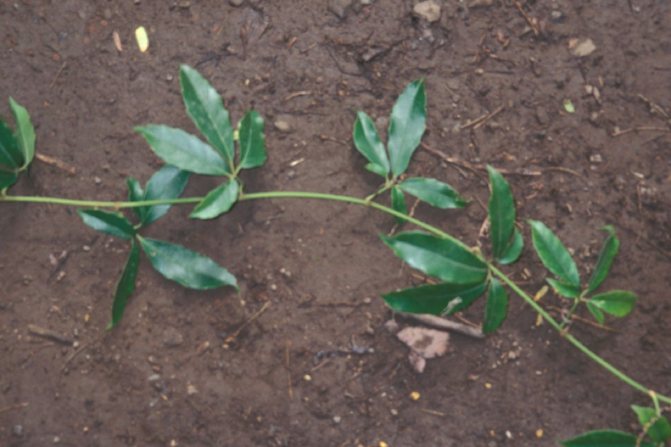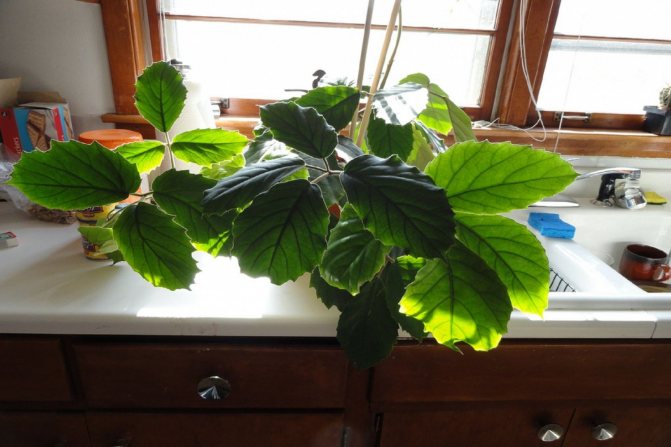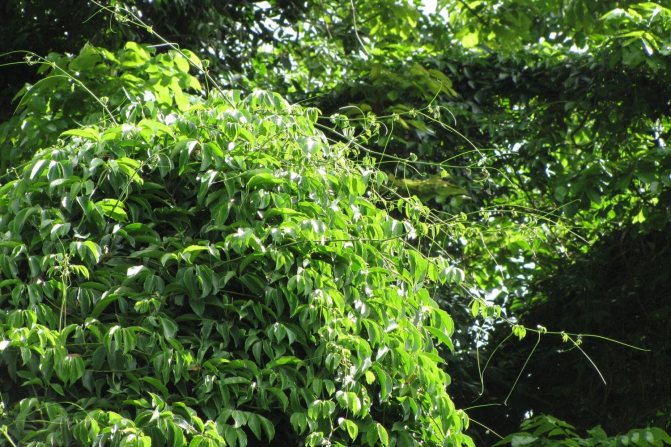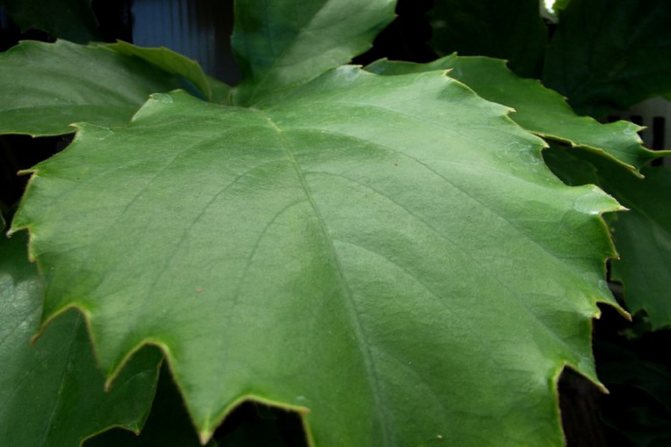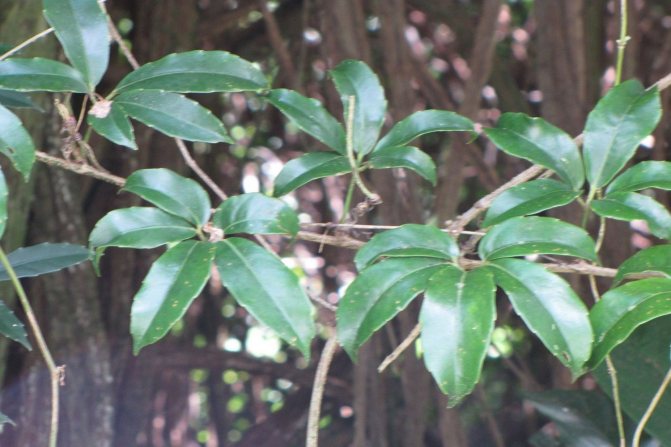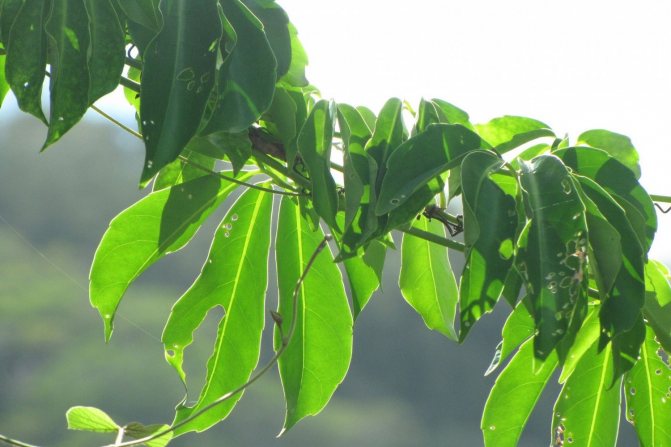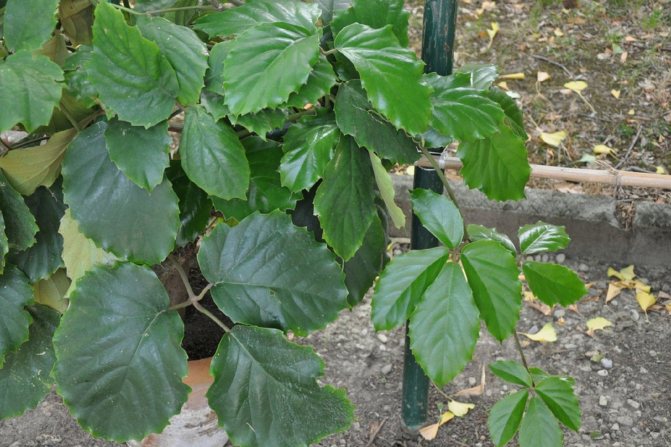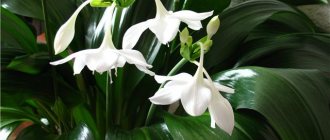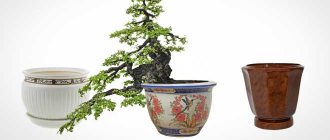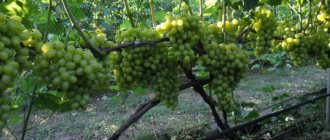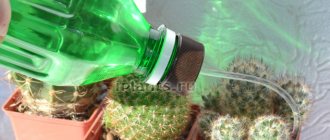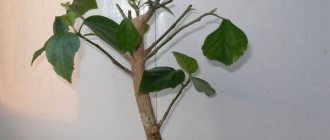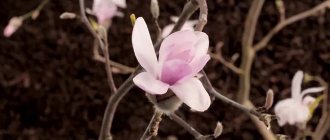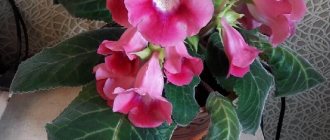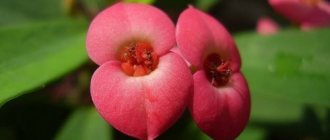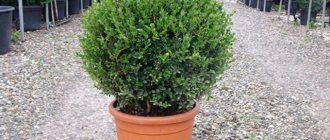Indoor grapes are perhaps the best solution for landscaping premises. If residents love clean air and home-made vines that wrap walls and ceilings, then such a plant will become their favorite. Indoor grapes are able to twist and refine the vertical surface intended for it in a couple of years - walls, indoor trellises, furniture, jambs, windows and other interior items.
Its bright green foliage, covered with fluffy brown hairs, attracts attention, soothes and cheers up the owners. You get the impression that you are in the forest. Indoor grapes perfectly purify the air and give it a tart aroma. For those who want to grow this wonderful plant, this short body of knowledge is intended, where you will learn about the types of grapes, growing conditions, rules of care and reproduction. Useful information will help you grow thick and juicy lianas, winding around the walls - a piece of real jungle at home.
Reproduction methods
The tetrastigma flower is propagated exclusively in a vegetative way. It is necessary to cut off the apical shoot or cut several cuttings from a young vine. Each cut should have 1-2 adult leaves. Cut the cuttings so that 1-2 cm of a bare stem remains under the petiole. The cut site is treated with a solution to stimulate the formation of rhizomes and planted in fertile light soil. The stalk must remain above the soil surface, otherwise the seedling will die.
Rooting takes place in a bright place at an air temperature of + 22 ... + 25 ° C. Keep the cuttings under a hood for the first week to prevent drying out. The greenhouse is aired daily and the soil is sprayed. Over time, the seedlings are accustomed to open air and begin to water abundantly.
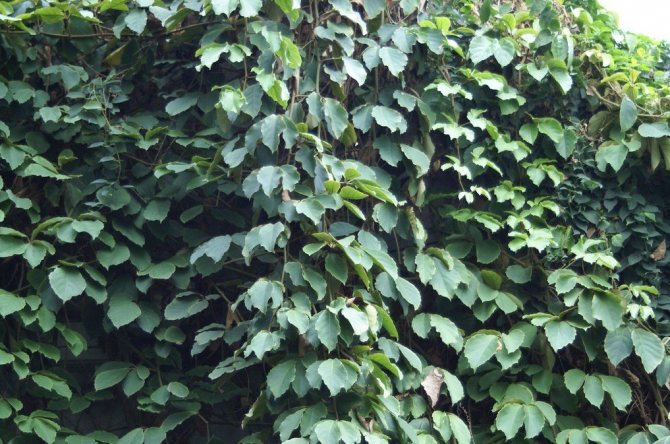
Mature lignified vines can be propagated by layering. Without separating the shoot from the main plant, it is dropped into the soil in the same or a neighboring pot. The vine is watered for 6-9 months. During this time, the shoot takes on its own massive rhizome. Closer to the mother plant, the branch is cut off with a sharp knife and the cut is processed with crushed charcoal. The cut will actively grow from the first days of independent life.
Cissus indoor grapes home care and reproduction
General information
The bushes are divided during transplantation. Cuttings can be propagated at any time of the year. For this, cuttings with 2 buds are cut and planted in small pots, several pieces each.
The temperature regime is maintained in the region of 20-22 ° C. Rooting takes place in 2-3 weeks. Cissus rhomboid root perfectly in water at a temperature of 18.
Antarctic cissus can be propagated by seeds that are sown shallow in the ground. The dive is carried out in the second leaf phase.
Cissus can be propagated in 3 ways:
- by cutting method;
- using seeds;
- dividing the bush.
The cutting method is usually carried out in the winter. To do this, take three cuttings, place them in a vessel and grow them at a temperature of 23 ° C. After a while, the cuttings should be planted in separate small containers. Care for the cuttings needs to be done correctly.
By dividing the bush, the flower is propagated at home in the spring, when the transplant is performed.With the seed propagation method, it is worth taking the seeds and planting them in small tanks, and after a certain period of time, plant them in small vessels. Care is needed competently for young plants.
General information
Reproduction of tetrastigma voigne
Vallotta. Features of home care
Reproduction can be carried out in two ways: layering and cuttings. In the first case, it is worth following some rules. Cuttings are cut from branches that are not yet lignified, but not from young shoots either. The vines should be ripe with good knots. Prepared cuttings, which should have 1-2 good knots, are planted in containers with prepared peat.
Then, the seedlings need to be covered with a film, to create greenhouse conditions for them for good rooting.
After a while, at a time when the cuttings will release good roots, they can be transplanted into separate pots.
It is possible to plant 2-3 plants in one. Since Vuanye's tetrastigma grows very soon and begins, it will be necessary to transplant it 2-3 times a year in a container 2 times larger than the previous ones. Along with this, always control the moisture content of the earthen coma, since overdrying can destroy a young sprout.
Reproduction by layering:
- Reproduction by layering is very similar to cuttings, only there is no need to cut branches.
- A good adult vine is buried in the ground in a specially prepared container.
- Along with this, the vine does not separate from the mother bush.
- After 8-10 months, with abundant watering of the daughter plant, it takes root perfectly.
- go to make sure that the roots are large and strong and only then separate the new plant from the bush.
- Along with this, there is no need to transplant immediately into a new pot.
All young tetrastigma seedlings require regular watering and, in fact, daily feeding. This continues until the plant is completely hardened and systematically produces new leaves and shoots.
How to propagate?
Several breeding methods are practiced. Cissus is a fast growing plant, so reproduction is not a problem.
- Cuttings. Cuttings are cut at any time of the year. The pot is filled with a light nutrient mixture with a high content of sand and peat. 3-4 cuttings are placed in one pot. Moisturize regularly, maintain a temperature of 20-22 ° C. The appearance of new leaves indicates successful rooting.
- By dividing the bush. Adult, heavily overgrown bushes during transplantation can be divided. In the planted parts, it is recommended to shorten the vines so that the plant has the strength to build up the root system.
- Seeds. By sowing seeds, Antarctic cissus is mainly propagated. The optimal sowing time is spring. A sand-peat mixture is poured into a small box, moistened. Seeds are distributed over the surface of the soil, lightly sprinkled with the same soil. Seedlings are kept under glass, systematically ventilated. After the appearance of the second true leaf, they are seated in separate pots with a diameter of 7 cm. Further transplants - as they grow.
Caring for tetrastigma voigne
Features of home care for the Radermacher flower
In order for the tetrastigma to develop perfectly, it must be planted in a huge tub. It is better to choose a bright place for placement, with shading from direct sunlight, otherwise there may be burns on the foliage.
In order for the plant not to shed its leaves, the light must be supplied within 12 hours.
The branches of the tetrasigma grow soon, therefore, you need to look after them and curl them on unnatural trellises or every other device. If this is not done in a short time, she will curl all nearby plants or objects, but this is subject to good care of her. In small rooms, vines grow up to 2-5 meters; in office halls and halls, such a plant can stretch its own branches up to 10-12 meters.
Plant temperature:
- Since the plant comes from warm places, the temperature also prefers high + 25- + 28 degrees. But even at lower temperatures, tetrastigma will develop normally.
- If the temperature drops below +10 degrees, then its growth slows down or, by and large, ends. Leaves will also begin to fall off.
The land should be chosen loose and sandy. It is possible to do it yourself by mixing the soil from the garden with soil from under rotting leaves and a small part of the sand. In addition, it is great to add little compost to such a mixture.
When planting, a good amount of drainage is poured into the pot.
Watering the plant:
- Watering tetrastigmus prefers regular and abundant watering.
- The soil ball in the pot should always be wet, especially during the growth of the plant.
- In the winter months, watering can be reduced a little so that the soil in the pot is a little wet.
- In addition, you need to moisturize the plant outside.
- Regular foliar spraying will have a beneficial effect on the quality and growth of foliage and branches.
Top dressing is carried out systematically during the growing season. This is done once every 10-15 days. Fertilizers for this process need to be selected complex.
Shaping and pruning
Pruned in spring or late winter. In young plants, lashes are pinched to enhance branching. In adult plants, shoots that are too long are cut to the bud next to the mother branch. It is recommended to remove weak shoots, to reduce the density of the bush. Excessive density leads to crushing of the leaves. Pruning rejuvenates old bushes. All lashes are cut to a meter. Cut shoots are not thrown away - they are used for cutting cuttings.
The support is used strong, reliable - it should easily support the weight of an adult liana. Ready-made plastic nets or taut cords will do. Tying young lashes to the support, they set the direction of growth, create the necessary shape.
Plant diseases and pests
Features of caring for chamelacium at home
Diseases in tetrastigma can appear due to improper care of it. If the plant does not have enough lighting, then its leaves will fade and eventually fall off, and the branches will stretch out.
Leaves turn yellow with insufficient watering or impoverished land. In this case, it is recommended to transplant the plant into a pot one size larger and renew the soil.
In addition, carry out a regular watering regime. When the leaves come into direct sunlight, especially after the abundant spraying with water, brown burns appear on them. The plant must be shaded from the sun, and damaged leaves must be removed.
A spider mite may appear on the plant. If the leaves turn yellow, and a cobweb is visible on the back, then it is time to use medicinal preparations for plants. It is also possible to rinse the plant a couple of times with a solution of soapy water. If the leaves become sticky to the touch, and small white midges appeared near them, it means that the whitefly has struck tetrastigma.
Against her, it is also possible to treat the plant with drugs or wash it perfectly with soapy water.
Diseases of cissus
- The main pests of indoor grapes are scale insects, spider mites and leaf aphids. When processing chemicals for pest control, it is necessary to strictly adhere to the manufacturer's recommendations and be extremely careful, since cissus leaves are quite sensitive.
- The leaf blades are deformed, bulges appear - the plant does not have enough moisture. It is necessary to spray with water.
- If the lower leaves curl up and darken, this indicates insufficient watering of the plant.
- If the leaves lose their color, this indicates the intensive growth of the plant and the lack of trace elements. You need to start feeding.
- Leaves are covered with mold due to poor drainage. In this case, the cissus must be transplanted into another pot with good drainage.
- Powdery mildew on the leaves indicates excessive watering. The watering schedule needs to be revised.
With proper care, which is not laborious at all, cissus plants will delight you with their beautiful appearance and at the same time absorb toxic substances from the air.
Periodic inspection of the plant, adherence to the rules of care helps to avoid most problems. But sometimes flower growers have to deal with pests and specific diseases.
Diseases
| Disease | Signs | Treatment |
| Powdery mildew | Petioles and leaves are covered with white bloom. After its removal, brown tissues are found. | Weak degree - biological fungicides (Fitosporin, Alirin). Running state - treatment with "Pure", "Jet", "Topaz". |
| Angular spotting | Refers to non-parasitic diseases. It is characterized by the appearance of yellowish-brown translucent spots with clear contours. | The affected leaves are cut off. The plant is treated with a solution of Bordeaux mixture or copper oxychloride. |
| Root rot | The foliage loses its gloss, turns pale, turns yellow and fades. The root part of the stem is softened. When transplanting, disheveled, rotten roots are found. | The plant is transplanted into a coarse-grained substrate, removing damaged roots. They adhere to the regime of abundant, but rare watering. The preparation "Fitosporin" is poured under the root. |
Description of tetrastigma voigne
The branches of this vine in natural conditions grow by 50 meters, from year to year adding 200 cm. Its leaves are huge, leathery, made up of five separate fingers, which are oblong-round or rhombic in shape. They are painted in a dark green color, which is covered with a rust-colored pubescence from the bottom.
On the leaves and young stems, in addition, there is pubescence - small silvery hairs.
In vines, the dilapidated parts of the branches become stiff, but they still remain elastic and will not be able to hold the entire crown on themselves.
Based on this, such a plant needs a support along which the branches will climb up. Many tendrils grow on the branches, thanks to which the plant clings to any nearby object and reaches for the light.
Tetrastigma blooms only in natural conditions. The buds are located high in the crowns of trees, along which the liana curled. The flowers are small, painted in a greenish tint.
Indoor grapes: structural features
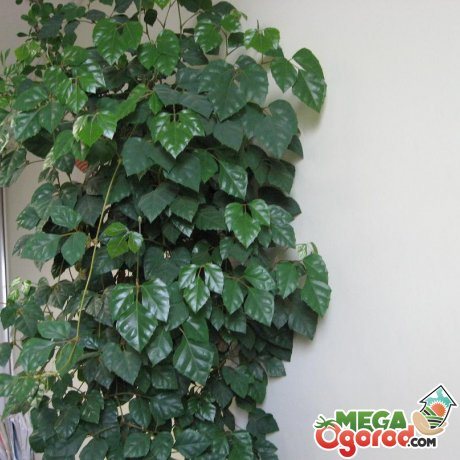

Indoor grapes are perennials, evergreens with climbing vines. It grows quite quickly, vines cling to vertical objects with the help of antennae. The leaves have a variety of shapes, depending on the species and variety - whole, ternary. More often they are jagged and resemble wild grapes. The plant does not bloom under indoor conditions, but sometimes this happens. Flowers are very small and inconspicuous inflorescences.
Indoor grapes are grown not for their flowering, but for their ability to cover large areas of rooms and purify the air in a short time.
The stems and shoots of the plant are rather fragile, therefore, flower growers recommend determining a place that is unique for it, so that in the future you do not have to transfer the grapes to another part of the house. Unpretentious and able to grow in any conditions. Indoor grapes are often grown in public facilities for this very reason.
The homeland of this amazing plant is America, Asia and Australia, their subtropical and tropical forests. Despite the unpretentiousness, he prefers quiet places where there are no winds, moderately humid and illuminated by diffused sunlight. It is customary to maintain the same conditions when growing it at home. Indoor grapes have a large number of species and varieties, but only a few are bred in the conditions of apartments and premises.
Care
This plant does not require any special home care. Tetrastigma tolerates dry air well, is undemanding to temperature, therefore, open loggias are often decorated with it, from spring to autumn.
Lighting
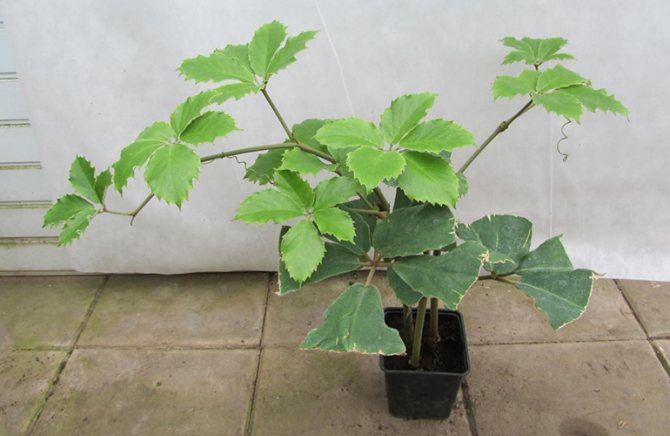

A pot with stems curling along the supports can be placed anywhere in the room. The plant does not need a special lighting regime, prefers diffused rays and quickly adapts to changes in the length of daylight hours. Usually the pots are placed on the east or west window, less often on the north, but on the south side it will have to be shaded. If the plant is comfortable, it responds with rapid growth.
Temperature regime
The optimum temperature for growing this flower in spring and summer is 20 - 27 degrees. At this time, it is better to put the pots with liana on the street or balcony. In autumn, with a decrease in daylight hours and natural cooling, the temperature of the content must be reduced: the pot is removed from the central heating systems. The optimal mode in the off-season is +12 - +18 degrees. In the southern regions, they are trying to grow this crop outdoors in winter. The flower can withstand +6 - +8 degrees, but only with very rare watering and with inconsistent outdoor exposure.
Watering
Grapes need moisture. The earthen coma should not be allowed to dry out: the liana is watered as soon as the topsoil dries out. He does not like a flower and waterlogging: he reacts to an excess of water by lowering the crown and dying off the branches. That is why there should never be excess water in its pan.
In summer, watering is carried out twice a week, in winter, when the temperature drops, once every two weeks, making sure that the soil does not dry out completely. If the air temperature does not change, then the summer irrigation regime is maintained throughout the year. Cold water should not be used, as the plant reacts sharply to it by dumping foliage.
Moisturizing
Homemade grapes grow in any humidity of the air, but the abundant crown begins to grow with frequent spraying. In summer, you can put the pot in a tray with wet pebbles. In winter, when the heating system is operating, it is recommended to place containers with water next to the pots. Spraying can be replaced by wiping the foliage, but with a large volume of the bush, this is difficult, therefore, flower growers once every 1.5-2 months arrange a warm shower for the grapes, not forgetting to close the earthen lump. But sprays for glossing this culture are not suitable.
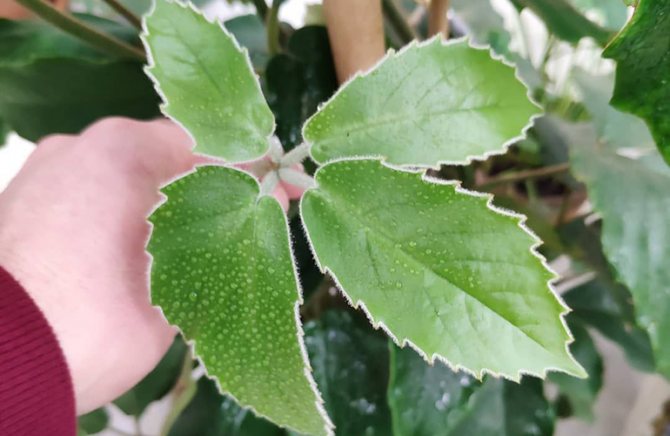

The soil
This flower is not picky about the earth. It grows well in any loose, fertile soil. You can take a universal soil and add vermiculite and sand to it. You can mix the soil yourself, taking turfy soil, leaf humus and coarse sand in equal proportions. The soil should be slightly acidic with a pH level of 6. A prerequisite for planting is good drainage for ¼ of the pot. Liana can grow in the same soil for a long time. To preserve its nutritional properties, it is advised to renew the top layer of the earth once a year.
Top dressing
From April to the end of September, this crop needs fertilization. In the care of tetrastigma, the classic scheme is used - once every 15 days. If it is required to suspend growth in the summer, feeding is either completely removed, or it is carried out every two months. Complex mineral fertilizers for ornamental crops are suitable for home grapes. In winter, the flower goes into a state of dormancy, so feeding is completely stopped.
Transfer
Young plants are transplanted only when necessary, when their roots have already completely filled the earthen lump. Mature grapes need replanting every 3 years. It is placed in a new pot using the transfer method. In this case, a new flowerpot is taken 3-4 cm larger in diameter than the previous flowerpot. If the flower has grown and started up long lashes, it can be left in an old flowerpot, changing only the top layer of the soil.
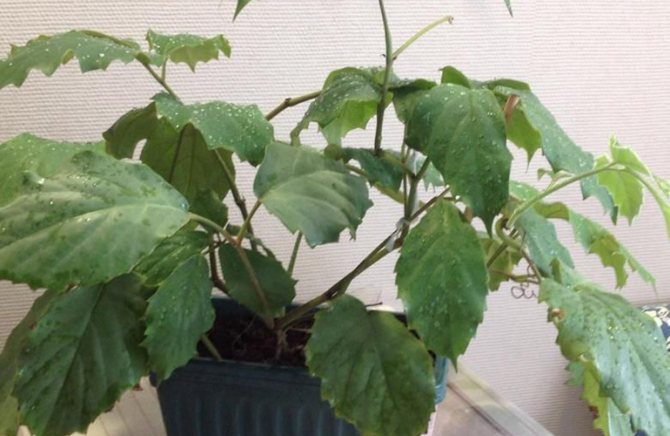

Shaping and pruning
Due to its rapid growth, the bush is pruned in early spring.In young plants, you can pinch the tendrils on the lashes. In adults, the vines are cut to the bud closest to the maternal branch. Be sure to remove weak shoots.
The flower needs support. For this culture, special plastic nets are used, or wooden pegs are installed and a fishing line is pulled between them, along which the vines are allowed.
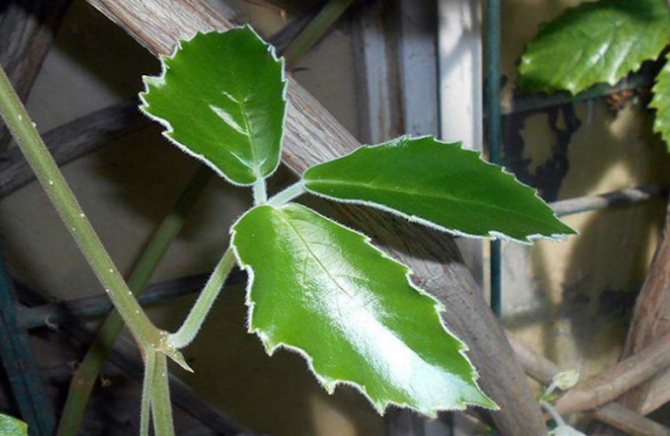

How to care for indoor grapes (cissus) at home
Cissus (Cissus) refers to a very popular unpretentious houseplants. It belongs to the Vitaceae family of over 300 species. Among the people, Cissus is better known as a birch (for the similarity of leaves with birch) or indoor grapes (by species relationship).
General information
Cissus is an original houseplant, popular with both beginners and experienced flower growers. Unpretentious, creeping and tenacious growth allows everyone to set up their own vineyard in the apartment. But before planting cissus at home, you should find out in more detail what this flower is and how to care for it.
Cissus belongs to the Grape family, therefore, almost all of its representatives are a vine with whole or dissected leaves. Like an ordinary vine, cissus grows upward, clinging to the tendrils of the supports standing next to it.
It blooms at home not often and not very beautifully - its flowers are small and unpresentable. Botanists count over 300 species of cissus, but only a few of them are used as indoor plants. Most often you can find Antarctic cissus, rhomboid and multi-colored.
It is an evergreen liana with serrated leaves resembling birch leaves, 12 cm long. It tolerates dry soil well, but needs light and does not tolerate high air temperatures.
Liana with long, thin stems, reaching 1.5-2 meters in length. It has compound leaves, consisting of three diamond-shaped leaves. It is very unpretentious, tolerates temperature extremes, lack of watering, shade and direct rays of the sun.
A more whimsical type of cissus; its leaves are dark green with silvery spots, the reverse side is pink. In winter, sheds leaves, which grow back in spring. Requires a low temperature - 15-20 ° С, and high soil and air humidity.
Cissus grow quickly and abundantly. In favorable conditions, their development is practically unstoppable, the shoots quickly entwine the supports and create a dense green cover. Therefore, they are often used for landscaping winter gardens. Undemanding cissus does not require special care and attention.
Indoor grapes grow well on windows, but they do not tolerate direct sunlight very well. Therefore, it must be shaded from the bright sun. I like the plant in the kitchen and near artificial light sources.
In the warm season, it gratefully responds to taking out to the balcony or veranda. But with the onset of cold weather, you need to timely hide the plant in the room.
Temperature
Indoor grapes are not picky about the room temperature - it is enough to maintain 18-20 ° C all year round. In spring and summer, when it is quite hot, it is not advisable to exceed the temperature of 25 ° C.
Cissus can tolerate heat and dryness for a while, but it is best not to expose them to such extreme stress. In winter, care must be taken that the room temperature does not fall below 16 ° C - this is the lower holding limit. Although the Antarctic cissus will be able to endure 5-10 ° C.
Caring for cissus is not difficult and does not require special tools and knowledge. It is necessary to moisten the soil and air in a timely manner, make the plant a support and periodically cut off overgrown vines.
Watering
The number of waterings and sprays will vary depending on the season.In summer and spring, during periods of high air temperatures and dryness, the number of irrigations and the volume of water should be increased. It is worth focusing on the state of the soil in a container with cissus - you need to water it as the soil dries.
Important! Watering should be done with soft, settled water.
In winter, leaf growth slows down, water evaporation almost stops, and accordingly, water consumption decreases. In this case, you need to water less often and not so abundantly. The signal for watering, again, will be the condition of the soil where the cissus grows.
Air humidity
Prolonged stay in a dry room will not bring anything good to cissus, so the leaves should be sprayed with water once or twice a week. In the summer, you can do this a little more often, especially if the room temperature is rather high.
In winter, spraying can be reduced or stopped altogether. The exception is multi-colored cissus, it must be sprayed every day.
Top dressing
Watering can be combined with root feeding. For this, any complex fertilizers for non-flowering plants or universal fertilizers for complex flowers, such as "Clean sheet", "Gilea" and the like, are suitable.
Cissus should be fed once a week during the warm season; in winter, fertilizers are not used.
Support
Cissus is a climbing plant, so it needs to be supported so that the whips do not spread across the floor, but cling to the antennae and grow up. As a support, you can use decorative posts, trellises made of wire or twine, metal mesh.
The plant will pretty quickly wrap its whips around any provided support and make it look like a green wall.
Pruning
Like grapes, cissus is periodically pruned and pinched. Pruning is carried out in the spring, with the beginning of active leaf growth. Remove old, dried leaves and whips, cut off diseased parts. This is done with the aim of rejuvenating the plant and removing possible breeding grounds for diseases and pests.
The pinching is carried out for a denser branching of the cissus. In the spring, the shoot growth point is removed, and the growth does not go up, but to the sides.
Important! If plant growth slows down in winter, this is a natural process, but a slowdown in summer indicates a lack of nutrition.
The fast-growing cissus is transplanted quite often. In the first five years of life, while the plant is actively developing, the transplant is done every year, later - once every two to three years.
As a soil for a plant, you can buy a ready-made soil mixture for vines, neutral or weak acidity. You can do it yourself. To do this, take in equal parts leafy soil, peat, humus, turf and sand. All are mixed and poured into a prepared container.
The transplantation procedure is carried out in the spring, after the plant comes out of hibernation. Transplanting is carried out each time into a new, more voluminous container. A layer of drainage is poured onto the bottom of the pot - pebbles, crushed stone, expanded clay. A small layer of earth is laid on top of it.
Then the plant is placed in the pot, gently spreading the roots in all directions. The rest of the earth is poured on top and watered.
Reproduction
Indoor grapes reproduce very well and take root in a new place. Sowing is rarely used - the Arctic cissus reproduces well with seeds. But most often the plant is propagated by dividing the bush and grafting.
By dividing the bush
It is necessary to divide the bush during transplantation, that is, in late March - early April. The selected root with basal processes is cut into several parts with a sharp knife. Each part is placed in a separate container with earth and watered. Rooters such as Epin can be used.
The planted rhizomes should be kept warm, at a temperature of 22-25 ° C and humid air. After three to four weeks, the first shoots and shoots should appear on the surface of the earth.
Cuttings
The easiest way, suitable even for a beginner, is propagation by cuttings.They are harvested at the end of winter, February-March, by cutting off a suitable shoot with two buds. Cuttings are planted in 2-3 pieces in containers with soil or peat and left for rooting.
However, cuttings of rhombic cissus take root well in water at room temperature.
You need to put containers with cuttings in a warm place, where the temperature is constantly at the level of 20-22 ° C. It is necessary to maintain high humidity in both the soil in the pot and the air in the room. Within three weeks, the cuttings will take root and give the first shoots.
Diseases and pests
Most of the problems and diseases in cissus are caused by improper care:
- mold and powdery mildew appear - there is excess moisture in the ground and insufficient drainage, you need to make a transplant;
- the leaves dry, deform and bend - dry air, you need to spray the leaves from a spray bottle;
- leaves begin to fall - lack of water, you need to water more;
- discoloration of leaves, tarnishing - the plant lacks nutrients, you need to increase the amount of feeding or change the mineral complex.
Cissus most often infect scabies, spider mites and aphids. Spraying and washing the leaves with soapy water is effective against pests. If the situation is difficult and soap does not help, you need to apply insecticides such as Fitoverm or Lightning.
So, in general, caring for cissus is not difficult - it is enough to water the plant in a timely manner and in the right amount, maintain the required humidity, feed and replant in the spring. Indoor grapes will certainly create a good atmosphere in the house and will delight the eye with green leaves.
She planted cissus Antarctic, while only one seed showed signs of life, she has such a hard body! When the spine appeared, I slightly helped him to free himself.
Although the spine itself is plump, I'm afraid to breathe on the air, I think I'll knock off something superfluous. Today I see inside the leaves of the cotyledon have already turned green, and the seed, as it was stone, has remained.
The decision was made through surgery to release the sufferer
Let's see what happens. But in my opinion, he himself would not have gotten out. Probably it was worth sandpapering the seeds, who knew that they were so thick.
Cissus love diffused bright light, and tolerate partial shade well. The brighter and brighter the lighting, the darker and larger the leaves will be. Plants can be placed both on the windows and at some distance from them. These vines develop normally under artificial lighting.
In summer, the temperature is considered favorable, ranging from 18 to 20 degrees, in winter from 16 to 20. However, Antarctic cissus tolerates temperatures well and 5 degrees. With a significant decrease in temperature or drafts, plants can shed their leaves.
Cissus plants are not particularly demanding on environmental humidity. Still, they should be sprayed several times a week. A multicolored cissus, which does not tolerate dryness, needs daily spraying.
In the spring-summer period, due to the large number of leaves and intensive growth, plants need abundant watering. In winter, it is reduced, while preventing complete drying of the soil. The water should be soft and settled.
Watering and moisturizing
Description
Tetrastigma has a branched rhizome and long, creeping shoots. In just a year, a liana can grow by 60-100 cm.In culture, branches grow by 3 m, and in the natural environment you can find vines 50 m long.Young stems are covered with smooth dark green or gray bark, but over the years they turn into curved, lignified branches.
Young shoots are covered with alternate petiole leaves 5 cm long. The diameter of one leaf can reach 35 cm. Each leaf consists of 3-7 lobes.These lobes have their own, shorter petiole. The lobes are elongated and have serrated sides and a pointed end. On a leathery dark green leaf plate dense, protruding veins are located. On the back of the leaf, short reddish-brown villi can be seen. From the many tiny glands on the bottom of the leaf, plant sap is constantly secreted and crystallized.
The smallest tubular flowers are arranged in small axillary inflorescences on rigid, short peduncles. Petals and bracts are yellow or greenish. In the center of the bud is a dissected stigma with four lobes. It was for him that the tetrastigma got its name. Translated from Greek, "tetra" means four, and "stigma" means stigma. But in a houseplant, flowers are almost never formed, so you will hardly be able to admire them with your own eyes.
Origin and description
Perennial of the Grape family. Wild species grow in India, Australia, Malaysia, on the islands of New Guinea. Tetrastigma is a Latin name that characterizes the structure of a flower. Vine stems are curly, strong. The leaves are large, divided into several lobes (from 3 to 5). Pubescence with brown hairs is characteristic. The edge is serrate. The arrangement is alternate, on petioles 5 cm each. Each lobe has its own short petiole. The size of an adult leaf reaches 35 cm. Flowering is not of particular interest - umbrellas with small flowers look mediocre.
As an indoor and wild plant, tetrastigma is distinguished by its rapid growth. The annual growth reaches one meter. The growth limit is 3 meters in an apartment, up to 50 meters in a natural environment. The bark of young stems is smooth, tender, bluish or dark green in color. Over time, the branches become lignified.
It is interesting! A few weeks after the appearance of the leaf, light grains that turn brown over time are formed on its underside. Out of inexperience, novice growers often mistake them for a sign of a disease. In fact, this is one of the features of the plant. Grains are formed as a result of crystallization of protruding juice drops.
Tetrastigma transplant
Tetrastigma is transplanted annually in early spring. The transplantation procedure, if necessary, is combined with pruning. For small plants, they try to completely renew the earthen ball in order to prevent acidification and the development of root rot. Large tetrastigmas in large tubs only replace the top of the soil with a new substrate.
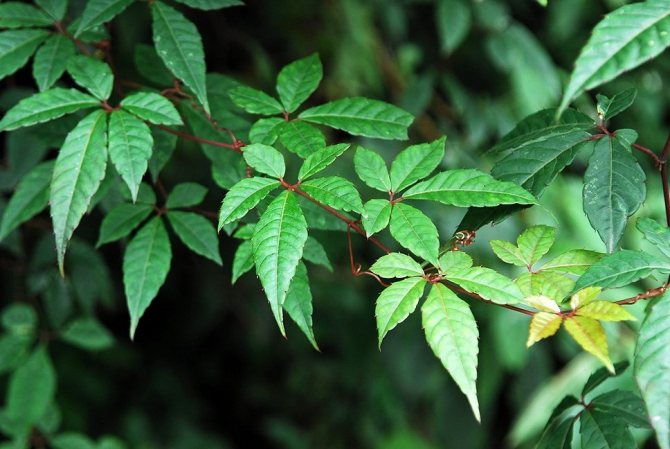

Pots for indoor grapes are chosen stable, one size larger than the previous one.
It is important to make large holes in the bottom and lay out a thick layer of drainage material. The soil is made from:
- sod soil;
- sheet soil;
- compost;
- river sand;
- peat.
The earth should have a slightly acidic reaction (pH 6). After transplantation, tetrastigma is kept in a bright place and watered abundantly.
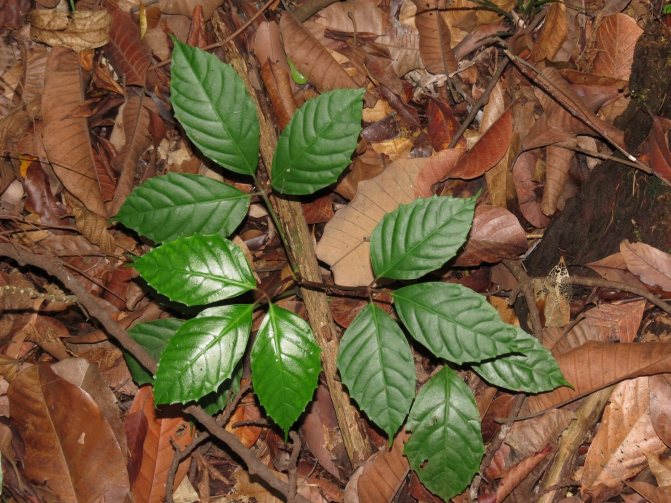

Transfer
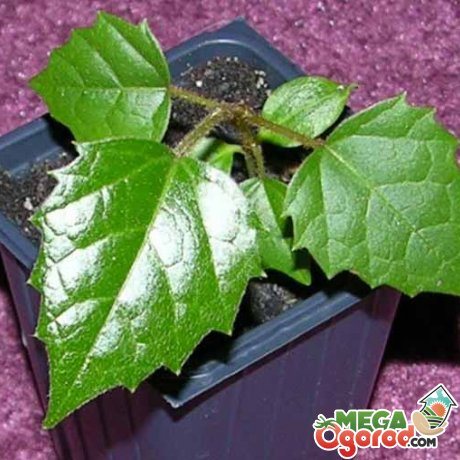

Indoor grapes grow very quickly. This becomes the reason for his annual transplant. It is produced in early spring. The plant is transplanted into a larger pot and the old soil is changed to fresh. The soil will include sheet soil, turf, peat, humus and sand. The proportion of parts is the same - one part of each component.
After transplanting, the plant is pruned.
All upper shoots are shortened. This will help the grapes to start growing faster and form side shoots, which is important for bushiness. For 4-5 years, the plant is transplanted every year. After that, you can carry out a transplant once every two years. It is always held in the spring.
Once the grapes are transplanted, apply a fertilizer containing nitrogen compounds. This will help the plant quickly adapt to the new pot and get used to the fresh substrate. The transplant is another important care condition. Without it, the plant will die very quickly.
Reproduction
At home, tetrastigma is propagated by cuttings and layering.
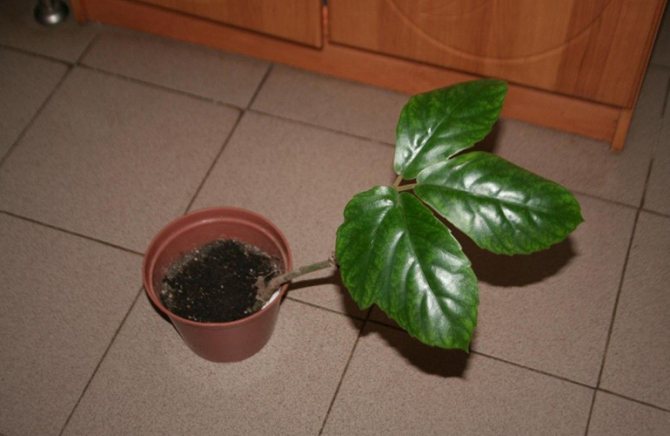

Cuttings.For cutting, choose semi-lignified parts of the vines. They should have well-formed axillary buds. 1-2 knots are left on each cutting. The place of the cut both on the shoot and on the mother plant is treated with crushed coal. For rooting, the cut pieces are planted in moist peat and covered with foil. In this case, one of the kidneys should be above ground level. The greenhouse must be ventilated daily. Rooted grapes should be kept in stable conditions at a temperature of +22 - +25 degrees. Spraying is carried out if necessary. If rooting is successful, a new shoot will appear on the cutting. On average, this happens within 3-5 weeks. Fortified plants are transplanted into the ground, 2-3 cuttings in one pot. During the first year, 3 transshipments are carried out.
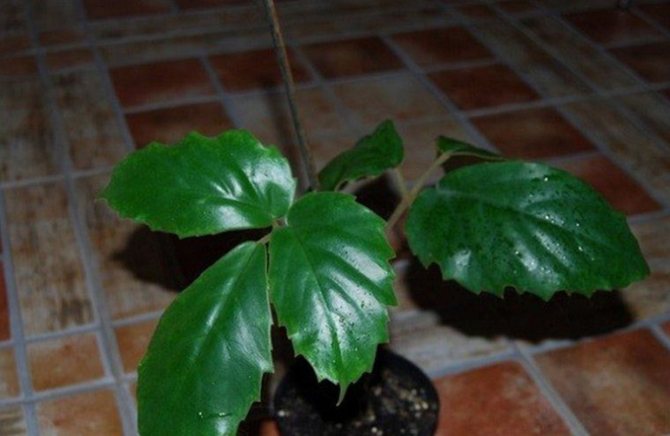

Layers. A pot of soil is placed next to the mother plant. A healthy vine is chosen, the bark is cut into it, and the place of the cut is added dropwise into a new pots. A pin or wire is used for fixation. When the cuttings are rooting, regular watering is important. In contrast to cuttings, roots on a young plant appear within 8-10 months. When the root system gets stronger, the layers are cut off.
Soil and fertilizer for cissus
You can use special soil for vines or mixed in equal amounts of leaf and sod soil, sand, peat and humus. A soil pH value of about 6 is required.
Cissus needs a large amount of nutrients for growth and development. This is especially evident in the spring and summer period. Fertilizing for non-flowering plants is carried out regularly once a week from April to September. In winter, during the period of "stagnation", feeding is not carried out.
Plants are transplanted every 2-3 years into a larger pot that provides good drainage.
Use of tetrastigma voigne
Vuagnier's tetrastigma is used for landscaping the premises. Quite often, this plant can be found in the foyer of concert halls or reception areas of huge office buildings.
Unpretentious, catchy, it constantly attracts attention and perfectly decorates any wall
In addition, tetrastigma is quite often planted in botanical gardens, where it occupies virtually the entire volume of the wall and stretches to the very ceiling.
Landscape designers use it in combination with other plants with contrasting color of leaves. To do this, they are planted in one tub and, over time, a combination of plants is formed.
Quite often, tetrastigma can be found in houses and small apartments. Its size is much smaller than in huge rooms. But nevertheless, it is invariably close leafy and stands out brightly against the background of other plants.
Interesting notes:
- Orchid, how to transplant - terms, benefits and rules
- Features of growing an orchid lady's slipper
- breeding and: features of Canadian blueberry care
- Lilac - shrub or tree: cultivation and description
Selected for important queries, relevant articles:
- Liriope belongs to the lily family. In nature, it can be found on the banks of rivers, in forests and on the slopes of the mountains of the states of Asia. Refers to long ...
- Celosia comb is a beautiful plant that has become widely known among all flower lovers. brightness and Unusual appearance, ...
- Curly lilac has many names, for example, hyacinth bean or dolichos. It belongs to the legume family. This plant is possible as ...
- Solanum belongs to the category of nightshade plants. It has a very unique appearance, which gives it a high level of popularity. But when ...
- Spathiphyllum belongs to the Aroid family. It is a long and evergreen plant that is cultivated in Asia and Europe as an indoor and ornamental plant….
- Plum is one of the most common trees. Its fruits have a pleasant sweet taste and tender flesh. Quite often, such a tree can be found in gardens, ...
Types of indoor grapes
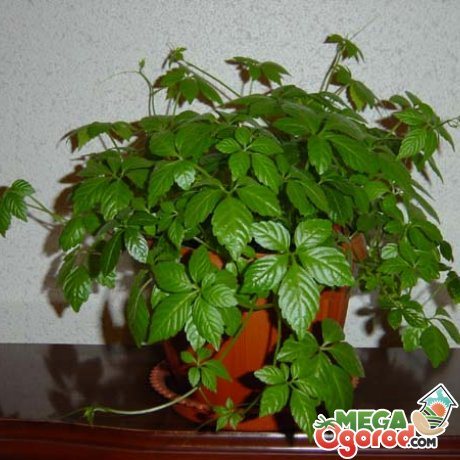

The most common and widely used is cissus. Less often they resort to growing tetrastigma, since the vines are quite heavy and are better suited for growing in a garden or greenhouses. Cissus, in turn, is subdivided into several subspecies.
They can be found in apartments, offices, houses and winter gardens. Allocate:
- Cissus Antarctic - often used for landscaping public institutions, schools, offices, meeting rooms. Unpretentious and not afraid of temperature changes.
- Rhombic cissus - it is this species that is widespread in home floriculture. Fluffy and dense greenery can mask supports and trellises, walls and other objects that support it. The leaves are diamond-shaped, small and neat. Vines can reach a length of 1.5 meters.
- Two-colored cissus - this plant is considered the most capricious among its fellows. It requires special conditions for growing and keeping. Therefore, flower growers rarely grow it. It differs from others in the color of the leaves - dark green with a silver pattern, maroon below.
- The quadrangular is a very unusual plant due to the shape of the leaves. Rarely grown in rooms.
Many grape lovers, without fear, take up the cultivation of tetrastigma. This view is certainly very effective, but it needs to be provided with a lot of space and a reliable, solid support. If the house is large, huge areas, in this case, this type of indoor grape can also be cultivated.
Tetrastigma Vuanye cultivation and care
Tetrastigma Voigne
belongs to the family of grapes (Vitaceae). The leaves of the plant consist of five leaves with jagged edges, sitting on short petioles.
The leaves of the Vuanye tetrastigma are red-brown below, powdered with white bloom, they are placed at an equal distance from each other. The stems of the plant are vertical, they are attached to the support with a stiff whisker. Nondescript flowers usually do not appear on indoor plants.
If the humidity is too low, which is often inherent in living quarters, the leaves of the Byanye tetrastigma wilt and lose their shine. Such a plant will lose its attractiveness and will not give new growth. This can be prevented by placing the plant pot on a pebble stand filled with water.
Care features
In March, fast-growing young plants need to be transplanted into large flower pots filled with nutritious soil. Adult tetrastigmata growing in large containers do not need a transplant, it is enough to change the top layer of earth in a pot with this plant. Gradually increase the frequency and abundance of watering and start feeding Voigne's tetrastigma.
October-February: at this time of the year, the plant needs good lighting and a temperature of 13-15 degrees. Make sure the temperature is not too high. Watering in moderation, do not overfill the roots.
Diseases and pests
Vuagnier's tetrastigma, standing in a draft or in a room with dry air, can infect spider mites. If there are few pests, then you can fight them with a solution of soapy water. In cases of severe damage, treat the plant with an insecticide.
LOW LEAVES.
The large five-leafed leaves of the Vuagnier tetrastigma willow if the air in the room with them is too dry. Place the plant pot on a pebble stand filled with water to increase the humidity in the room.
YELLOW LEAVES.
If you find that the young leaves of tetrastigma have turned yellow, then this is most likely a sign of a lack of nutrients. Make sure that the plants are regularly fed the necessary feeding (once every two weeks).
FELT COLLARS.
These pests can hide under a white, fluffy bloom. Remove them from the plant with a paintbrush. Wipe the leaves with an insecticide diluted in water.
Description of the plant
Liana of the grape family.In indoor floriculture, it is common as an ampelous plant. Popular names - birch, homemade grapes. In nature, there are about 300 species. Most of them grow in tropical and subtropical climates. Liana releases antennae for fixation on supports. The leaves are split or whole, depending on the variety.
The apartment rarely blooms. False umbellate inflorescences consist of pale, small, nondescript flowers. The decorative foliage gives the cissus a decorative effect. Grown in hanging pots. Growing difficulty level is initial. Suitable for landscaping apartments, offices, glazed balconies.
Interesting! It reacts to the creation of favorable conditions with rapid growth. Quickly braids the proposed supports. Shoots are numerous, densely leafy. Cissus is often used in winter gardens.
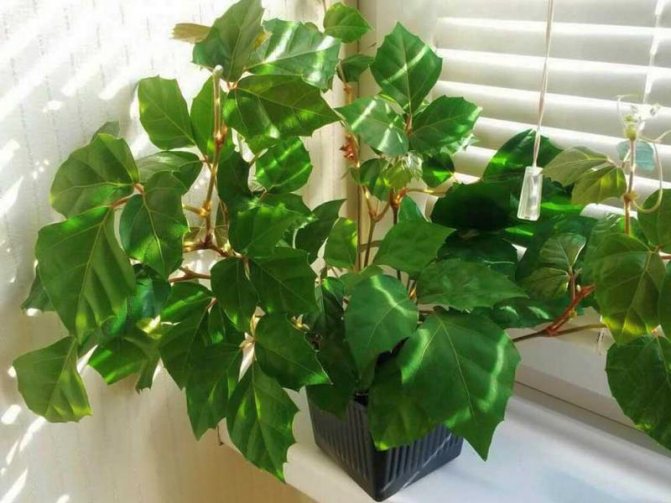

There are many varieties of cissus, but at home, most often, the following are grown:
- Antarctic Cissus, also called Diana Kangaroo. These are evergreen, climbing vines. The leaves are small, heart-shaped, with jagged edges. The flower has drooping shoots. The color is green small inflorescences. The size of the leaves is about a centimeter long and 5-8 mm wide.
- The quadrangular cissus looks very unusual. Vines have very thick, tetrahedral shoots, and the leaves themselves have an unusual, three-lobed shape. This flower, unlike the others, grows very slowly.
- Bicolor cissus is less common than other plant species. This is the same ever-flowering vine, but its appearance is significantly different from other home grapes. Cissus leaves reach 10 cm in length and 5-8 cm in width, have a very interesting color. The color is dark green, with silver spots, underneath the leaves are dark, almost claret. Blooms with yellow inflorescences, collected in umbrellas.
- The most popular among flower growers is the rhomboid cissus. This evergreen vine requires an openwork support, which is almost invisible among the shoots. The leaves are green, have a complex shape. Each of them consists of three diamond-shaped parts, the underside of them is light matte, with a reddish tint. The shoots are very long, they can reach 1.5 meters. They are attached to the support with thin antennae. The stem and cuttings are covered with reddish pubescence, which makes the plant even more attractive in appearance.
Cissus is a thermophilic plant, the optimum temperature in summer and spring for it is 25 degrees. In winter, it should be kept, like other indoor plants, at a temperature of about 18 degrees. Different types of cissus perceive a drop in temperature differently - Antarctic cissus will easily tolerate a decrease in this indicator to 5 degrees, while for a bicolor species, the minimum temperature should not be lower than 16 degrees. It is important to never expose the plants to drafts, as this will cause some or even most of the leaves to fall off.
Since the plant is native to the tropics, it needs good lighting. Cissus will grow best near a window on the south side. However, direct sunlight is contraindicated for the plant, so if you expose it outside in summer, it is better to place the pot in diffused shade. Most of all, the diamond-shaped cissus needs light, it completely stops growing in the shade.
Watering and moisturizing
Watering is an important requirement for cissus care. Since the plant has a lot of leaves, it evaporates a lot of moisture in the warm season. At the same time, it needs abundant watering and good air humidity. Cissus must be constantly sprayed. However, excessive humidity can also be harmful, particularly during winter. In the fall, cissus almost stop watering, you should do this every 3-4 days. In this case, it is necessary to spray the plant twice a day, since the air in the room is drier in winter.
In summer, cissus needs water, but do not allow moisture to stagnate, the soil in the pot should not be too damp. This is especially important for a two-tone look. It is recommended to shower the plant regularly during the summer.
Cissus should be watered with soft, settled or filtered water. In the warm season, the flower is also regularly fed, about once every two to three weeks. Any fertilizer for decorative, non-flowering, indoor plants is suitable for feeding. The fertilizer must contain a complex of minerals and vitamins. In winter, it is not worth feeding cissus, since during this period it hardly grows and is in a state of hibernation.
For cissus to grow well, it should be replanted annually for the first five years. After that, you can replant the plant after a year. The soil for this can be different, with neutral or underestimated acidity. A mixture of sod and leafy soil with an admixture of humus, peat and sand is suitable. You can use this mixture:
- Peat.
- Leafy land.
- Sod land.
- Humus.
- Sand.
All components in equal parts. It is better to replant the plant in spring, it is also important to ensure good drainage at the bottom of the pot. After transplanting, it is necessary to cut off the tops of the shoots, this will not only provide the plant with growth, but also make its shape more bushy. It is not necessary to cut off shoots only during transplantation; this should be done as the cissus grows, at any time of the year.
Cissus can reproduce in three ways:
- Cuttings.
- Seeds.
- By dividing the bush.
Plants are usually propagated by cuttings in winter. Take 3-4 cuttings, they are placed in a small pot and grown at a temperature of 22 degrees. After rooting takes place, the cuttings are planted in separate small pots.
By dividing the bushes, the plant is propagated in the spring, during transplantation. And seed reproduction is typical for Antarctic cissus, they are also sown in small containers, and then planted in small pots.
Plant species
There are only 9 species in the genus of tetrastigma, but only 2 of them can be found in culture. The most popular among florists and available for sale is the Vuagnier tetrastigma. The plant has a thick, rough stem with several branches. On the surface of the petioles and young shoots, there is a reddish pile. Leathery or denser leaves are bright green. They have a jagged edge and are separated by 3-5 diamond-shaped lobes. The top of the sheet has a glossy finish. The leaves are opposite. In the places of internodes near the petioles there are spiral tendrils with which the vine is attached to the vertical supports.
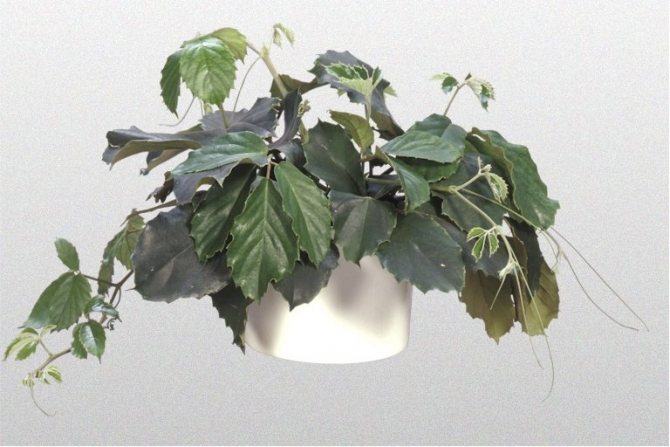

Tetrastigma Vuanye
During the flowering period, loose umbellate inflorescences on short, rigid peduncles are formed in the leaf axils. White-green buds have a prominent heart and small, tough petals. In place of the flower, a round, multi-seeded berry is tied.
Tetrastigma lanceolate is another species that can rarely be found in culture. The plant has darker leaves. They are lanceolate and are sometimes compared to small fish. The lobes are bent back in an arc along the central vein. The leaf plate is denser, fleshy.
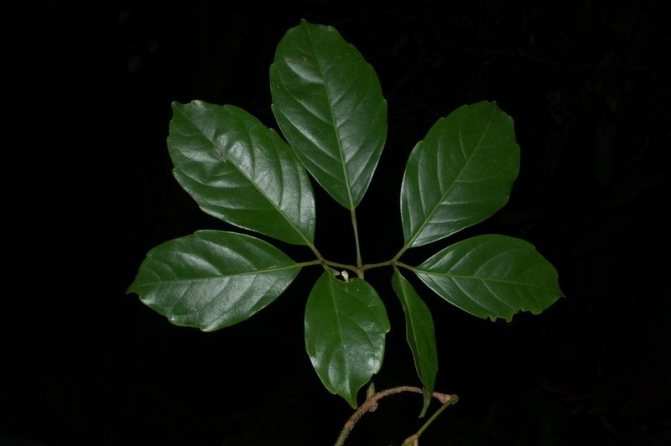

Tetrastigma lanceolate
Varieties
Nine species of this crop have been studied in the wild, but only three of them are suitable for home cultivation.
Voigne
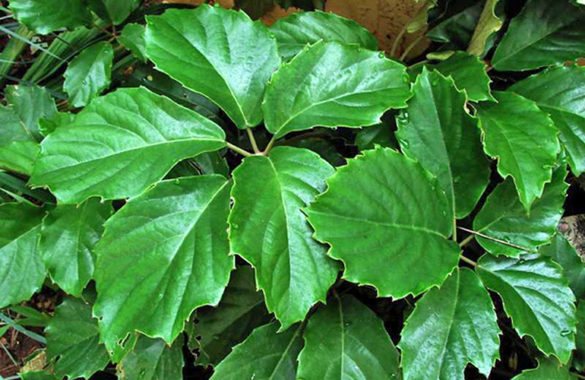

Plant with large, five-lobed leaves and moderately climbing vines. A distinctive feature is the color of the leaf plates: at the bottom is matte with a reddish-brown tint, and at the top it is shiny, saturated green. In places of internodes on the vines, spiral tendrils stretch out, which cling to any support, allowing the plant to quickly braid everything around.
Lancet
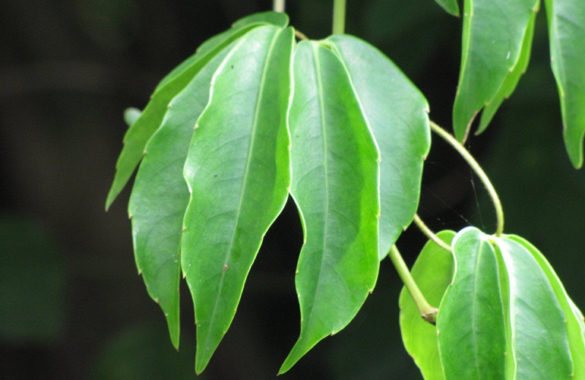

Less popular view. It got its name because of the lanceolate shape of the leaves, which in appearance resemble fish. Unlike Vuagnier, the lanceolate appearance has a denser leaf blade.Its edges are clearly bent back along the central vein. A peculiarity of the species is the vulnerability of young animals: the slightest touch to the leaves can lead to the dumping of whole shoots.
Obovate
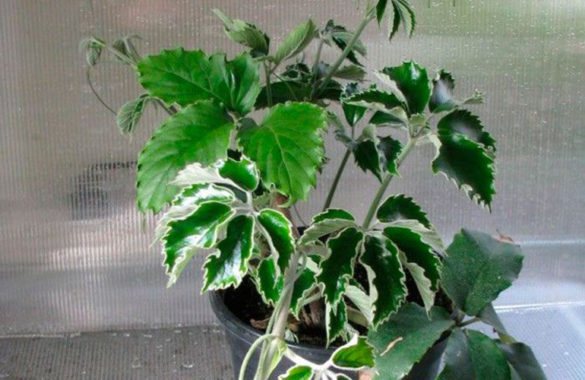

A variety of room tetrastigma, a distinctive feature of which is the method of attaching the leaves pointed at the edges to the petiole. Their sharp edge is directed to the middle, and blunt outward. The color is dark green with a thin light edging on top and gray-green on the back. The veins are smoothed out.
Growing problems
Homemade grapes are considered an unpretentious plant, but with errors in care, flower growers may face problems.
- Due to the lack of lighting, the shoots are stretched, and the crown turns pale. In winter, the flower can be placed under a phytolamp or fluorescent lamp.
- When the temperature drops, the grapes shed their leaves. The situation will be corrected by rearranging the pots with a flower in conditions comfortable for this culture.
- In the absence of top dressing or due to improperly selected soil, the leaves turn black, become small, the number of lobes on one petiole decreases.
- Dry indoor air leads to the appearance of spider mites. The symptom of the disease is drying of the crown, a powdery coating on the leaves and a small cobweb between the shoots. In the initial stages of the disease, a warm shower and changes in conditions of detention help. In advanced cases, insecticides are used.
- Violation of the rules of care leads to infection with a mealybug. The pest leaves a characteristic white bloom on the leaf. To combat, use an infusion of tobacco, garlic, calendula, or chemical insecticides. Each sheet must be gently wiped with a cloth dampened in the solution.
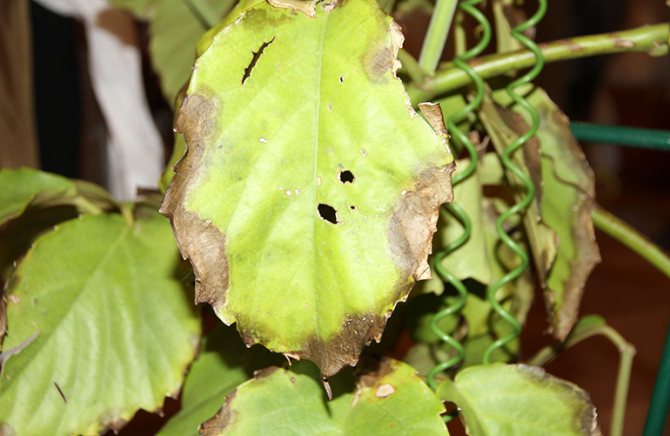

Growing conditions
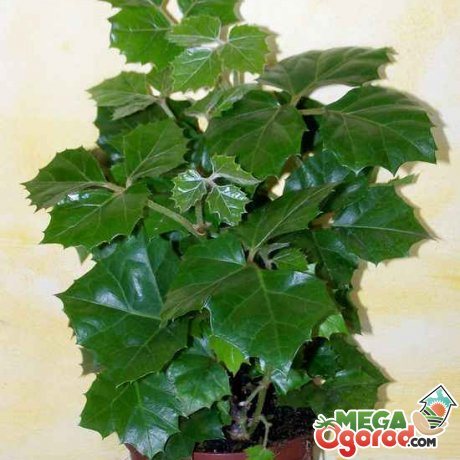

The air temperature for almost all types of indoor grapes should be 22 ° -25 °, not higher. In winter, the temperature can be reduced to 18 ° -20 °. As long as the bush is small and has not completely attached to the vertical support, it can be taken out into the fresh air in summer. Temperature drops are undesirable for cissus, especially for a two-colored species. Try to avoid this.
When choosing a place for grapes, choose rooms in the east and west direction, where there are no drafts.
Indoor grapes love bright, but diffused lighting. It is better not to place it near the windows. Choose niches for it in the walls or places where sunlight will fall, but not direct sunlight. The plant is shade-loving, but dark places, without any light, are undesirable.
The increased dryness of the air is not suitable for indoor grapes. He will die very quickly. Prefers moderately humid places, but not damp. It is necessary to constantly monitor the moisture content of the soil and prevent the earthen coma from drying out. The optimal composition of the soil will be a mixture of leafy soil, peat, humus, turf and sand. The ratio is 1: 1: 1: 1: 1. Moderate humidity, bright and diffused light, optimal temperature - will be the key to the lush and beautiful growth of outlandish vines.
Tetrastigma Voigne Care
This indoor vine does not require much maintenance, but for additional information, we can recommend the following.
Seat selection
Based on the illumination, tetrastigma can grow and develop without problems both in light, in diffused light, and in partial shade. It is not demanding to the temperature of the content and does not suffer from a lack of air humidity in the apartment. What she doesn't like is drafts. The main thing is that there is enough room for her to grow.
Soil selection
Almost all representatives of grapes are not demanding on the soil and can grow on all types of soils. If you take ordinary garden soil and mix it with a small amount of sand, then the cutting will be accepted unambiguously.
Watering and air humidity
Vuagnier's tetrastigma loves watering, but very moderate. In winter, watering is drastically reduced and watered as needed so that the soil does not dry out at all. Air humidity does not play any role.
Top dressing
When growing Vuanye's tetrastigma, you can do without fertilizing, but in order for it to retain its decorative effect longer, it is possible and desirable to feed it. During periods of active growth, in spring and summer, nitrogen-based fertilizers can be applied, about 2 times a month. At the same time, the dose can be reduced, somewhere in half from that indicated in the instructions for use of the fertilizer.
Reproduction
After cutting or pruning, you can call it whatever you like, there are many cuttings that can be successfully used for propagation. As mentioned above, it is enough to stick the cuttings into ordinary soil (you can add a little sand) and they will definitely be accepted.
Possible growing problems
If you really deviate from the conditions of detention, then certain problems are possible. The fact that such problems exist can be determined by the condition of the leaves: they can curl, dry, become stained, wrinkle, become moldy, etc. In this case, it is worth thinking about and starting to look for the cause leading to such a problem. The reason may be very dry indoor air (it is also harmful to humans), poor ventilation, too low temperature, lack of nutrients, etc. In any case, you should determine the cause and try to solve the problem.
In conclusion, nevertheless, it should be said that the place of Vuagnier's tetrastigma is not in small-sized apartments, but in spacious halls, lobbies or greenhouses of buildings and structures with large areas. It can safely take its original place in the wide halls of cinemas and theaters, as well as in the spacious corridors of administrative buildings, where living decorative elements are so lacking. Its place is in huge offices, where people are busy with production problems and they need to be constantly “recharged” with positive energy. Vuanye's tetrastigma is simply created for such purposes.
Subtleties of care
Care is simple, not laborious. To increase decorativeness, it is recommended that you familiarize yourself with all the plant requirements for the microclimate. Competent care of cissus at home will allow you to avoid attacks of pests, diseases and loss of decorativeness.
- Temperature. Cissus likes moderate warmth. Optimal temperatures for summer are 18-25 ° C. Autumn and winter - 18 ° C. Withstands temperatures as low as 10 ° C. It reacts to drafts and temperature changes by dropping leaves.
- Lighting. The light is bright, diffused. Light requirements vary by variety. Antarctic cissus reacts calmly to shading - it is used for landscaping poorly lit hallways and bathrooms. The diamond-shaped species has increased requirements for light.
- Watering. Due to the rapid growth and abundance of green mass, the plant is demanding on moisture. Water abundantly, avoiding stagnation of water in the pot. Maintain constant soil moisture. After the surface of the substrate has dried, the next watering is carried out. Closer to winter, watering is reduced.
- Humidity. High humidity is the main component of care. Sprayed regularly. In winter - twice a day, in summer - once. Not too voluminous plants are bathed in the shower. In large plants on supports, the leaves are wiped with a wet sponge.
- Top dressing. Any complete, balanced mineral formulation is suitable. The intervals between dressings are a week. Fertilizers are applied only during the period of rapid growth. In winter, top dressing is not necessary.
- Transfer. Until the age of five, they are transferred to another pot annually. After that, they are kept at intervals of 2-3 years. The soil mixture is made up of equal amounts of peat, sand, leafy, turfy land, good humus. Drainage is required.
- Pruning. The optimal period for pruning is spring. Old ones that have lost their decorative effect are shortened. Pinch young shoots to enhance branching. He is calm about pruning, does not get sick, quickly grows.
Important! If the cissus is not organized a dormant period, then feeding in the winter does not stop. Fertilizers are applied twice less often and in a lower concentration.
Lighting
Tetrastigma Vuanye is a light-loving plant, but direct sunlight is contraindicated for it, because from them the leaves of the flower get burns. Therefore, it is advisable to grow home grapes near the east or west window. Yes, you can put the pot on the southern windowsill, but here you need to remember to shade the plant at noon.
Vuagnier's tetrastigma needs a lot of bright sunlight. Its lack leads to a strong elongation of the shoots, which in turn reduces the decorative value of the plant. The southeastern and eastern parts of the house or room will be especially welcomed by the tetrastigma.
The temperature for the plant should be maintained at 22 ° C. Closer to the winter period, the indicator can be lowered. It must be kept at a temperature of 12 ° C during the cool season. At too high temperatures, creeper leaves can lose their elasticity. This phenomenon can be adjusted by the number of waterings.
The optimum temperature for Tetrastigma Vuagnier during the resting period in the room is maintained at 14-22 ° C, but it should not be less than 12 ° C.
... The plant grows well in bright, diffused light. The illumination level should be in the range of 3000 - 5000 lux. It can grow under artificial light, but in shaded places, with insufficient lighting, it practically does not give young shoots, and those that appear quickly die off.
Do not allow direct sunlight to fall on the leaves. This can cause both burns and drying of the leaf blade.
Tetrastigma propagation by cuttings
Reproduction of tetrastigma at home is available by cuttings. As a material, the tops of the shoots with a bud and two grown leaves are cut.
The cuts are treated with a means to enhance rooting, and then the cuttings are rooted in peat mixed with sand or wait for the roots to appear by dropping the branches into the water.
You should also create greenhouse conditions by covering the cuttings with foil and maintaining the temperature at about 24 ° C. When the cuttings are rooted, they are transplanted into a pot of potting soil for mature plants.
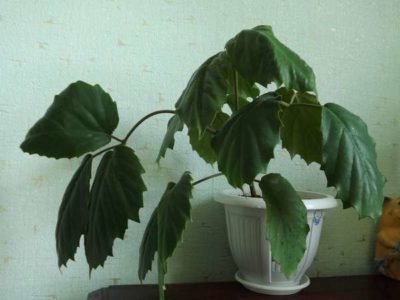

Taking shelter
This is the first stage of spring work. In different climatic zones, cover is removed at different times, in the south, some varieties do not cover at all. In general, it is necessary to remove the shelter from the vine only after a stable warm temperature has been established on the street.
It is clear that the further north the vineyard is located, the later the harvest time:
- in the southern regions it is possible already in April;
- in the middle lane - in early May;
- in the north, in Siberia and the Urals - in late May and early June.
The vine is not opened abruptly, but gradually. This enables the plant to smoothly adapt to temperature and environmental conditions. In any case, the vine will receive stress, but with a smooth opening, this stress is minimized.
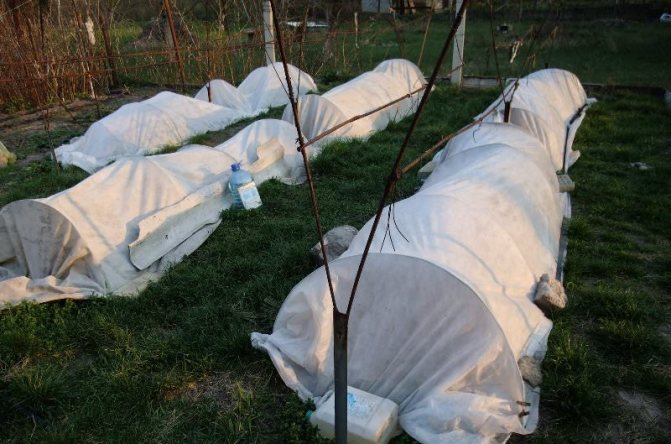

After the final removal of the shelter and the drying of the vine, it is tied to a support, a trellis.
Examine the grapes carefully. It is necessary to identify all areas of the vine that have suffered during the winter: frozen, rotten, moldy, broken, etc. If the vine has rotted, dried out, or otherwise damaged, it is pruned back to healthy tissue. All sections must be treated with garden varnish or another substance.
Make sure there are no suspicious growths that could indicate developing bacterial cancer. Eliminate all damage and suspicious areas. Burn biomaterial after pruning to avoid spreading infection.
Damaged bushes are watered and fertilized at a reduced rate until they recover. When the inspection is completed, it is recommended to carry out preventive spraying of grapes with copper sulfate. This measure will protect the vine from recurrent frosts, as well as from fungal diseases.
Watering and humidity
Home grapes are a very moisture-loving plant. And in order for home grapes to please with lush foliage, it is important not to allow the soil to dry out, and to moisten the soil as soon as it dries to a depth of 1-2 cm.Experienced gardeners recommend growing liana in special pots for indoor plants with automatic watering. This approach greatly reduces the risk of overdrying the earth ball.
Despite the moisture-loving nature, homemade grapes do not tolerate stagnation at the roots. After all, such a phenomenon can lead to rot. Therefore, do not forget to drain the excess liquid from the pallet, after 1-2 hours the irrigation field.
Tetrastigma takes root well in the dry conditions of a city apartment. But it is still advisable to spray its foliage with water from a spray bottle at least once a week. But such a procedure can be carried out only in the warm season. In winter, especially if the crop is grown in a cool room, spraying should be canceled.
Homemade grapes need fresh air at any time of the year. Therefore, do not forget to regularly ventilate the room. But keep in mind that the plant does not tolerate drafts and sudden changes in temperature. So take the flower to another room while airing.
We suggest that you familiarize yourself with: Description and characteristics of the indeterminate tomato variety Carbon
Humidity is important for Tetrastigma Voigne during particularly hot summer days. At moderate temperatures, this figure can be maintained at 55%. If necessary, Tetrastigma Vuanye is sprayed with warm water in the evening and the plant is watered abundantly during the active growing season throughout the summer.
In autumn - winter, with a decrease in the amount of light and a decrease in air humidity, the plant goes into a period of forced dormancy. With a forced dormant period, from October to February, the plant is watered moderately, but the substrate should not be allowed to dry completely.
During the growing season, Tetrastigma Vuanye is watered abundantly, as the topsoil dries up. At the same time, well-settled soft water, without chlorine impurities, is used for irrigation. In winter, at low air temperatures, watering is reduced, preventing the substrate from drying out.
... Indoor grapes tolerate dry indoor air well, but, nevertheless, it is recommended to spray it periodically, since in conditions of high humidity it feels more comfortable.
Types and features of reproduction
Every florist should know how this or that plant propagates. Ornamental indoor grapes have two types of propagation: by cuttings and by dividing the bush. Both of these methods are considered to be quite good and almost always have a positive result.
Propagation of indoor grapes by cuttings is quite simple. It is enough just to cut off the top of the shoot you like and place it in water until it takes root. This process is fast. Good roots will appear in a week.
The division of the bush is carried out during the next plant transplant. The bush can be divided into several parts, but this must be done very carefully so as not to damage the root system.
How to plant
Planting and transplanting is best done in the spring. Spread the drainage mixture at the bottom of the pot. The soil suitable for growing cissus should not be acidic. It will be better if it consists of a mixture of turf, leaf and peat soil, sand and humus (all ingredients are mixed in equal parts).
After planting, the tops of the shoots are pruned to allow the vines to grow and branch quickly. Pruning is carried out not only after planting or transplanting, but also throughout the year. The goals of each regular pruning are to stimulate the growth of the vine and the formation of its crown.
Soil for tetrastigma
As for the soil, it should be nutritious and loose, and also have a neutral or slightly acidic reaction.
The substrate can be made by mixing leaf and turf soil, garden soil, and perlite in a ratio of 1 to 1 to 0.5 to 1. Do not forget about drainage. The container for growing should be taken with holes.
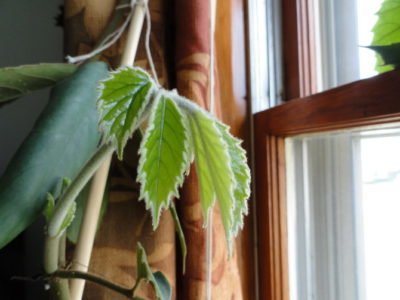

[collapse]
Top dressing so that cissus does not develop brown spots on the leaves
The flower needs nutrients for development. This need is especially evident during the growth period - in spring and summer. Top dressing should start in mid-spring. In the summer - every 2 weeks, from mid-autumn to the end of winter - every 6 weeks. You can take mineral complexes for decorative medicinal plants.
If brown spots appear on the leaves of cissus, it means that it lacks nitrogen. It is necessary to use fertilizers with a high concentration of this substance. Usually they are added to boiled non-hard water, which should stand for some time before that, and then water the plant.
If brown spots on cissus leaves are accompanied by tarnishing and lethargy of the leaves, then the cissus lacks fertilizer. This can be eliminated by changing the brand of nutrients or increasing the feeding.
Main types
There are 3 main types of this plant.
- Tetrastigma Vuanye... It was originally an inhabitant of a tropical climate. Has an impressive size. Differs in the presence of a brown cannon on the back of the sheet. The inside of the foliage has a brilliant emerald tint.
- Tetrastigma lancentaia... Representatives of this species have elongated leaf lobes and strongly depressed veins. For its appearance, it is often called "fish".
- Tetrastigma obovate... The leaves of plants belonging to this species have the shape of an inverse egg, which determines the name of the variety. The blunt end is at the outer end of the leaf, while the point of attachment to the stem is pointed.
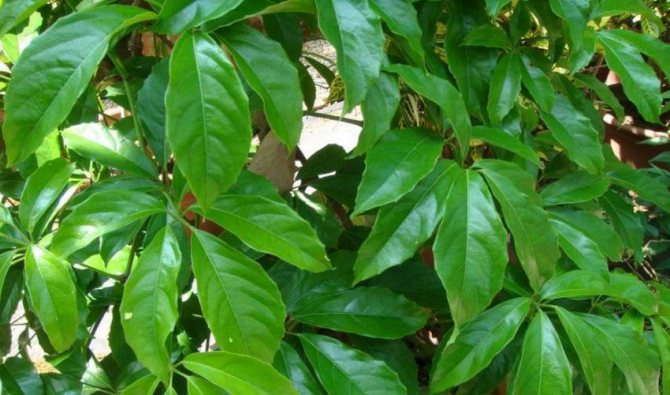

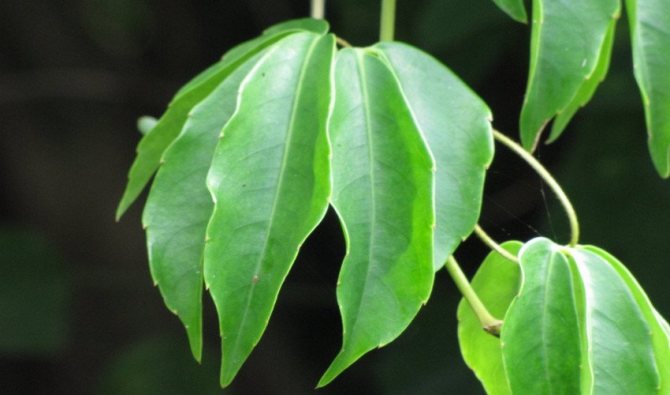

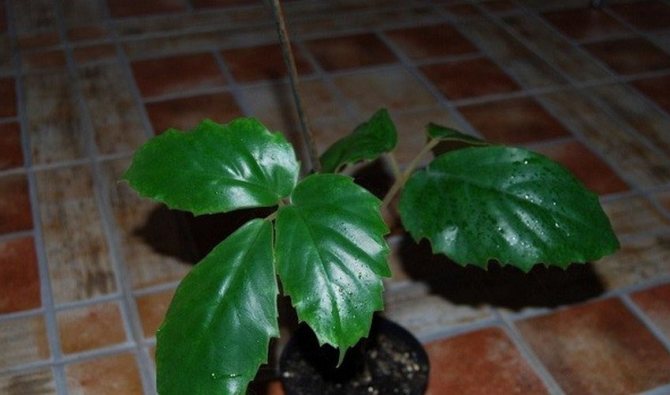

Indoor air
Cissus is a houseplant, an ivy grape from the tropics and subtropics, and there, as you know, the air is quite humid, and it should be the same in the room where the pots with this flower are located. Multicolored cissus is especially picky about high levels of air humidity. Therefore, it needs to be sprayed frequently. This is especially true for the winter period. Florists say that in the winter months, multi-colored cissus should be sprayed at least twice a day. In the summer, the procedure can be shortened, but it cannot be abandoned altogether. Indoor grapes should also be wiped with a damp cloth.
Temperature
This ornamental plant for the home belongs to heat-loving crops. And from spring to autumn, it is desirable to maintain the indoor temperature within + 23 ... + 27 ° C. In the summer, you can take the plant out to the balcony or in the garden, but it is worth choosing places for it where the direct rays of the sun or sharp gusts of wind do not reach.
In winter, grapes require cooler conditions (+ 15 ... + 17 ° C). But it is important to remember that lowering the temperature to +12 ° C will be critical for the flower. And in such cold weather it will quickly freeze and die.
Types of tetrastigma
We grow mainly in the form Tetrastigma Vuanye... It is a massive evergreen vine that lignes over time. The foliage is dark green in color, finger-like, covered with fluff below, petiolate. The flowers are small, greenish in color, but when grown indoors, flowering is almost never observed.
Tetrastigma lanceolate this species can also sometimes be found in our florists. It has darker and thicker foliage than Voignier, but overall the two are very similar.
Tetrastigma obovate a feature of this species is the petiole foliage, which is attached to the petiole with the sharp end of an oval leaf, and looks up with the blunt side, the edges of the leaf plate are serrated, the color is dark green, the bottom is pubescent with villi.
Grapes on the windowsill - two harvests
When growing grapes at home, you can achieve two harvests annually. This is done in the following way.The bush removed for winter storage is brought into a warm room on the 15th of February and watered well. After 13-15 days, the buds will begin to bloom, and after 25-30 days flowering will come. By May-June (depending on the early maturity of the variety), the berries are already ripening.
3 weeks after harvesting, the bush is taken to the glacier (in a cool place), where the temperature is not higher than +4 and stay there for up to 50 days (one and a half months). After that, the bush is brought into the room and at the end of October, at the beginning of November, juicy grapes will ripen in the apartment again.
After fruiting, the grapes must be transplanted, removing up to 13 roots and replacing the ground with 13. With a double harvest, it is required to give more fertilizers - usually 100 cm3 of 10% slurry solution per liter of earthen clod volume, once a week, in addition, 2 g of superphosphate is necessarily added for each liter of slurry.
Transfer and transfer
For the development of an active root system in the tub for the first 2-3 years of growth, the pots (tubs) are repeatedly replaced, gradually increasing their volume, transferring the bushes from a smaller dish to a larger one. When it enters the fruiting period, transshipments stop, and transplants are made every 2-3 years.
When transshipping, the bush is removed from the pot without disturbing the earthen coma and rolled into a pot, larger in volume, with the addition of earth. At the same time, the drainage and upper soil layers 2-3 cm thick are necessarily replaced, the rest of the coma is not disturbed. Transshipments are done after the end of the next growth period in grapes, that is, when young shoots and leaves are ripe. In the summer, no more than two transshipments are made.
The transshipment is carried out as follows: when growth has stopped, the bush is watered (but not abundantly) with water, the pot is tapped from all sides and, covering the top with a hand, is turned over; if the earthen lump does not separate, take a stick and, pressing it through the drainage hole, push it out of the pot.
With a blunt object, clean off 2-3 cm of the top layer of the earth and the drainage layer. Examine the root system and remove all rotten and dead roots; they differ from living ones in a darker color or even a dark brown color.
Drainage is arranged in a new dish, then 1-2 cm of sand is poured. The nutritious earth is poured in such a layer that the lump of the overwhelmed bush placed in the pot is 4-6 cm below the top of the pot with its upper edge. After that, the earth is poured and compacted between the walls of the pot and on top by 2-3 cm. Compaction of the earth, in order to avoid damage to the roots, is done with fingers or a blunt object. After transshipment, abundant watering and spraying of the bush with warm water are carried out.
For the first 7-10 days after transshipment, the bush is removed to a shaded place.
The transplanting technique is the same as for transshipment, only when transplanting, up to 13 soil is removed from the earthen coma, up to one third of the roots and up to one third of the crown are cut out.
The transplant is carried out in early spring or autumn, while in the first year the plant is given rest, destroying most of the fruits in their embryonic state or even removing them altogether.
Dishes (tubs, pots) are disinfected during transplantation.
It is not at all difficult to grow grapes from cuttings or seeds, the main thing is patience and attentiveness. The reward will be sweet and tasty berries.
Protection from pests and diseases
This is also a necessary spring measure that must be carried out every year after the grape shelter is removed. Preventive treatment is carried out In spring and summer in several stages:
- spraying with iron sulfate immediately after removing the shelters (300-500 grams per bucket of water);
- preparations "Actellik", "Poliram" or "Bi58 new" at the time of swelling and opening of flower buds - but only if the bush was sick last season;
- preparations "Horus", "Topaz", "Bi58 new" - when 3-5 leaves appear on the branches.
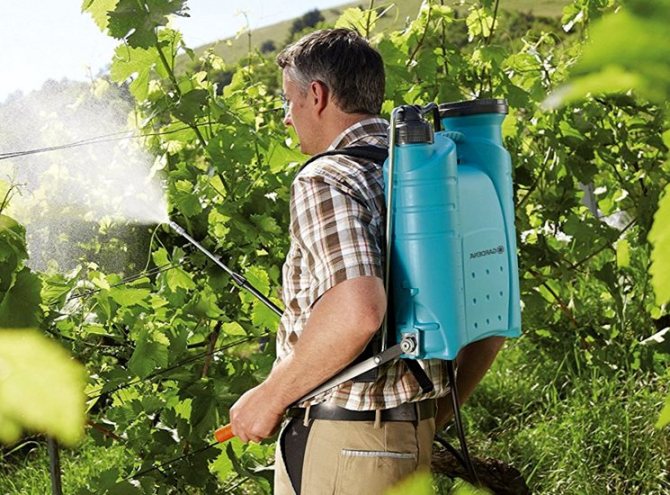

The universal preparation Nitrofen is excellent for spring processing of grapes.It is very effective, however, it should only be used before bud break. Application in subsequent periods can negatively affect the taste and quality of the fruit, increase the content of pesticides in them.
Such a proven remedy as Bordeaux liquid is excellent for the preventive protection of grapes from fungus and parasites. The composition of the Bordeaux liquid is simple: it is copper sulfate and lime, dissolved in water. However, the effect of the drug is simply amazing. Traditional Karbofos helps with most pests, but it is better to use Oxyhom for ticks.
Iron sulfate diluted according to the instructions will help to cope with chlorosis of the leaves. Treatment with this drug is carried out before bud break. By the way, iron vitriol of the kidney can also protect from recurrent frosts.
Read also: Medicinal properties and uses of raspberries
Types of tetrastigma
Tetrastigma Vuanye - This perennial vine with climbing shoots is the most common species. Under natural conditions, the length of such a shoot can be about 50 m. The main stem is covered with slightly lignified bark. The petioles, with the help of which the leaves are attached to the shoot, are rather thick. The leaves themselves are dark green, leathery, consist of 3-5 lobes, with denticles along the edges. The bottom of each leaf is covered with brown hairs. Liana is attached to the support with antennae. It blooms in the form of an inflorescence with small greenish flowers. After pollination, the fruit ripens in the form of a round berry.
Tetrastigma is a genus of plants belonging to the Vinogradov family. Its number is about a hundred species, and is home to South Asia, as well as North Australia. It is grown here mainly in indoor conditions and is nicknamed "indoor grapes".
These are large vines with lobed foliage. The length of lianas in the wild can exceed 50 m. Flowers are small and do not have decorative value.
Tetrastigma is an easy-to-grow crop, which also reaches impressive sizes at home, but it is usually shortened to 2-3 meters. It grows rapidly and can increase by 1 m in one year, although this characteristic depends on the conditions of detention.
Benefit and harm
The main advantage of tetrastigma is the rapid development and growth of green mass. Large leaves perfectly clean the air, so indoor grapes irreplaceable in office premises... It is believed that it is able to reduce the harm from radiation from office equipment: computers, printers, copiers. Thanks to tetrastigma the air is purified, saturated with oxygen.
INFORMATION! No harmful effects on the human body have been noticed.
Spring pruning
Since the culture bears fruit only on young shoots, old branches must be disposed of regularly. Usually spring pruning is carried out quite radically - sometimes the shoots are trimmed to 90% of their length. Such pruning rejuvenates the bush, allows to activate the rapid growth of young branches.
Annual shoots are trimmed to the base, even small stumps are excluded. If the branches are of small thickness, you can cut them off with a pruner; for thick ones, you need to take a saw. Shoots are cut strictly perpendicular to the main trunk so that the cut site is as small as possible. Take a look video on the topic of spring pruning of grapes.
Important: if the grapes belong to the non-covering variety, prune before the start of sap flow. If you delay, the damage to the crop can be substantial. When an already awakened vine is pruned, the juice at the cut site flows so actively that it is sometimes impossible to stop it.
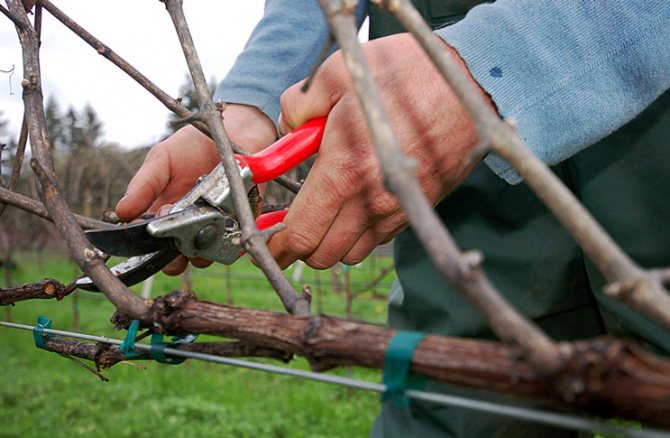

Summer care
In the summer, there is much less work with the vine - all the most difficult and basic stages are supposed to be performed in the spring. However, even in the summer you cannot sit idly by - if, of course, you want good harvests.
Watering the vine and loosening the soil in the garden is an important step in summer grape care.In addition, it is also important to take care of new fruiting shoots, properly feed the plant and protect it from diseases and pests. Also, in the summer, pruning is carried out, pinching the tops of young shoots.
The main summer work is aimed at ensuring a good harvest in the current season:
- growth points on young shoots are cut off so that food goes into the ovary, and not for the growth of young greenery;
- pinching is also used to form bushes;
- thinning and pruning of leaves 2-3 weeks before harvesting.
The latter measure is applied to those leaves that shade the bunches.
Nitrogen fertilizers are not used in summer, the emphasis is on potassium and phosphorus. The fact is that nitrogen leads to the rapid formation of greenery to the detriment of the quantity and quality of fruit ovaries.
At the end of June, a mineral complex is introduced: azofosk or nitroammofosk. But use only water-soluble fertilizers, as grapes cannot fully assimilate dry granules.
From the end of July, foliar fertilizing begins to be applied. Dissolve in a bucket of water:
- liter of wood ash;
- 20 grams of sugar;
- 1.5 grams of copper;
- 1 gram of boron.
Foliar dressing is carried out by spraying: spraying should be done on the lower part of the leaves. It is better to carry out the procedure in the morning or evening, when the sun is not particularly active.
Important: if a spring examination revealed diseased and weak plants, try to feed them less often and less abundantly in the summer. The long-term practice of professional winegrowers confirms that the "hungry" vine recovers faster and copes with diseases.
Disease protection
Of course, most of the disease prevention work is done in the spring. But in the summer, you should not relax: if there are signs of damage to the foliage by pests or fungi, immediately spray the plant with a solution of Bordeaux liquid or with suitable preparations;
Now you know how to properly care for your vineyard in spring and summer. The main work falls on the spring, while in the summer there is less trouble, but attention to the shrubs, nevertheless, is required. Having mastered the basic requirements for care, you can easily grow a healthy vine and enjoy the wonderful taste of juicy, large berries.
Difficulties in growing
Despite the unpretentiousness of the plant, some difficulties may arise during cultivation.
Most of them are easy to overcome if you pay attention to the violation in time:
- Elongated shoots... This symptom is a consequence of strong darkening, which can be corrected by moving the flowerpot closer to the light source. In this case, it is better to cut the vines.
- Brownish spots and dry leaf edges. The reason is most likely too intense light, which led to the burn. It is better to rearrange the pot with the plant in a darker place, and remove the affected foliage.
- Brown spots on foliage. If at the same time the leaf lobes fall off, we can talk about the effect of a low temperature. In this case, it is necessary to increase the heating of the room.
- Yellow leaves and spider webs on the inside. This symptom indicates a spider mite lesion. The damaged parts must be cleaned of cobwebs and treated with an insecticide.
- Brown blotches at the bottom of the leaves and a sticky coating. The reason lies in the attack of the shield. The plant can be cured using insecticides.
- A plaque like cotton wool in the sinuses. This means a mealybug attack. As in previous cases, insecticides should be used against pests.
- White dots and sticky deposits on the inside of foliage and the presence of white midges. The appearance of these symptoms indicates the reproduction of the whitefly. Leaves can be wiped with soapy water. If this alternative method does not help, systemic insecticide treatment should be carried out.
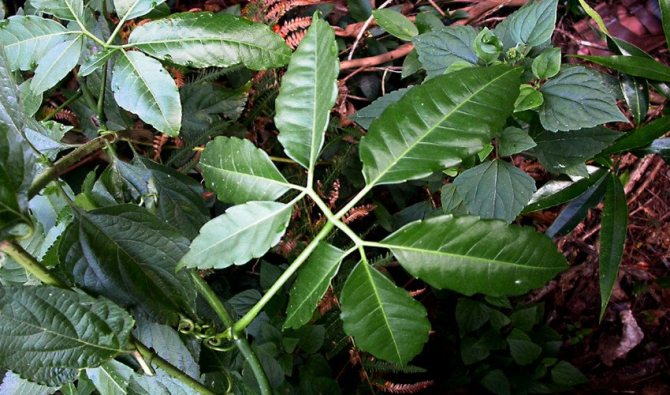

Tetrastigma is a beautiful plant that does not require much maintenance.If you approach the cultivation of home grapes correctly, it will delight its owners with luxurious vines for a long time.
Temperature regime
Cissus will feel more comfortable at high temperatures, since, as already mentioned, the tropics and subtropics are considered its homeland. In the summer and spring, the temperature in the room where the indoor grapes stand should not fall below 18 degrees, but it is better if the thermometer is at around 25 degrees. In winter and autumn, such high temperature indicators should not be achieved, and it will be quite enough if the air temperature in the room is 18 degrees. In addition, in the summer, it is recommended to take the pots with this flower outside, where they will feel much better.
Despite the fact that the plant is thermophilic, it can easily withstand a temperature drop of up to ten degrees. But the flower should not be in such conditions for a long time. Much depends on its type. Since the Antarctic cissus will not suffer much even at a temperature of five degrees, but the multi-colored one needs a constant indicator of at least 16.
It is also worth noting that drafts are categorically contraindicated for this plant, since they can lead to leaf fall.
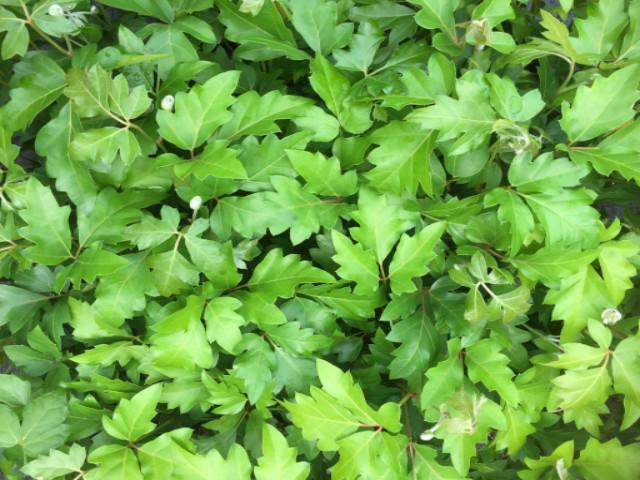

Trimming and supporting
The plant does not need pruning as such. And this procedure is carried out only to curb the growth of indoor grapes. If you decide to cut the crop, then use only well-sharpened tools for this. In addition, during the event, try not to touch the young leaves of the vine, otherwise it will drop them along with the shoots.
The shoots of Vuanye's tetrastigma grow rapidly. And if the stems of the creepers fall on top of each other, then due to the thickening they will not have enough light. This will cause the plant to shed its leaves. Therefore, it is important to guide the growth of the vine shoots using a thick metal support.
Types and varieties of cissus: photo video, names and description
Erysipelas includes over 300 plant species. The most common species listed below and some of the cultivars bred within them of such a flower as cissus can be found on this page.
Antarctic cissus (Cissus antarctica) more often referred to simply as cissus. It has antennae, which cling to the support. Leaves are oval, large, light green with coarsely toothed edges, ranging in size from 5 to 8 cm. The front surface is dark green, the reverse side is slightly lighter, the veins are with a slight brownish pubescence. For a year, cissus can grow by 1 m, its shoots reach a length of 3 m. Green flowers are collected in inflorescences.
Please note: in the photo - one of the types of cissus - rhomboid (Cissus rhombifolia).
Especially unassuming. Shoots are distinguished by greater refinement and elasticity, reaching 1.5 meters. They recognize it by pinnate leaves, sometimes with a reddish bloom, trifoliate leaves are composed of simple diamond-shaped leaves. Flowers of this particular species, after pollination, form into red berries.
Photo
In the photo below, you can appreciate the appearance of the tetrastigma, as well as the shape of the flowers of this indoor grape:
Why do the tips of the leaves dry on the indoor cissus flower?
Light-loving plant. He needs a bright diffused light, for example, for a diamond-shaped flower. The Antarctic species, on the other hand, requires partial shade. Office spaces or hallways work well. However, it is worth protecting the plants from direct sunlight, especially in the fresh air in summer.
All types of cissus can be used as ampelous plants, for landscaping vertical walls dividing rooms, or trellises. The exception is multicolored cissus. This species thrives best in a tropical window as an epiphyte.
It is necessary to maintain room temperature, Cissus discolor and Cissus amazonica prefer at least +18 ° C, Cissus antarctica and Cissus striata tolerate temperatures below +12 ° C in winter. In summer, you can take it out to the loggia, the main thing is to prevent a draft. Cissus is still a houseplant, so when it gets cold, it is necessary to bring indoor grapes back into the house so that the leaves do not fall off.
It is necessary to provide a high level of air humidity only for the Cissus discolor so that the crown grows. This can be done with regular spraying or warm showers in the summer. That is, you can put the plant in the bathroom and gently walk along the stems with the pressure of water at a temperature of + 30 ... + 35 ° С.
A similar procedure should also be carried out with plants that have a dense crown. Otherwise, cissus leaves gradually dry out or take on a strange shape - convex or concave. The excess liquid must then be poured out of the pan.
Another reason why cissus leaf tips dry out is often dry air. You need to spray the plant with a spray bottle and repeat the procedure regularly in the summer.
Pruning if cissus leaves fall
Pruning is carried out at any time of the year, and if the lower leaves of the cissus fall off, it must be cut by на in the spring. In other cases, the flower is cut in half and the stems that are left without cover are removed. If these are plants that twist up the support, pinching is carried out in order to give splendor and density to the crown. It so happens that in winter, with an insufficient amount of light, cissus lets out powerless stems, which die in spring or give even weaker shoots. In this case, they must be removed in early spring.
- After pruning at home, care for a flower such as cissus should be correct: put the plant in a well-lit place, water, if indoor grapes are transplanted, start feeding in a month.
- If the leaves suddenly began to fall off, there are two reasons: draft and heat. You can change the position by moving the flower to a different location.
However, such symptoms may indicate decay of the root system. Check if you are overflowing with cissus!
If the leaves suddenly began to curl and fall off en masse, this means that there is not enough oxygen in the soil. It is necessary to loosen the soil every 15 days.
When the lower leaves of cissus fall off, do not worry, this is not a problem, but a normal phenomenon for a flower - it grows.
Reproduction and planting of tetrastigma indoors
Under indoor conditions, tetrastigma reproduces only in two vegetative ways. Generative reproduction occurs only in the wild, in a more comfortable natural environment. In order to obtain a plant, you can purchase a cutting (with or without roots) in specialized stores. Shoots are usually cut from the tops of the stems or young vines. Both planting methods give impressive results. The tetrastigma flower is a very tenacious plant that is easy to get at home.
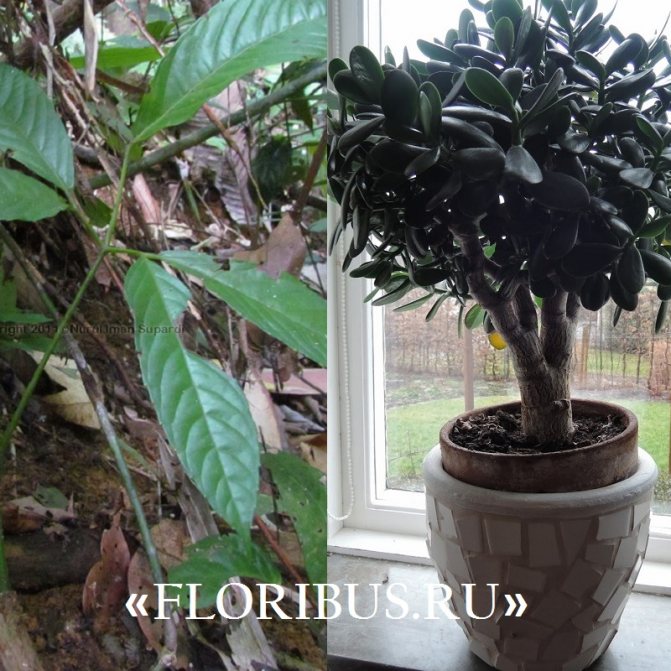

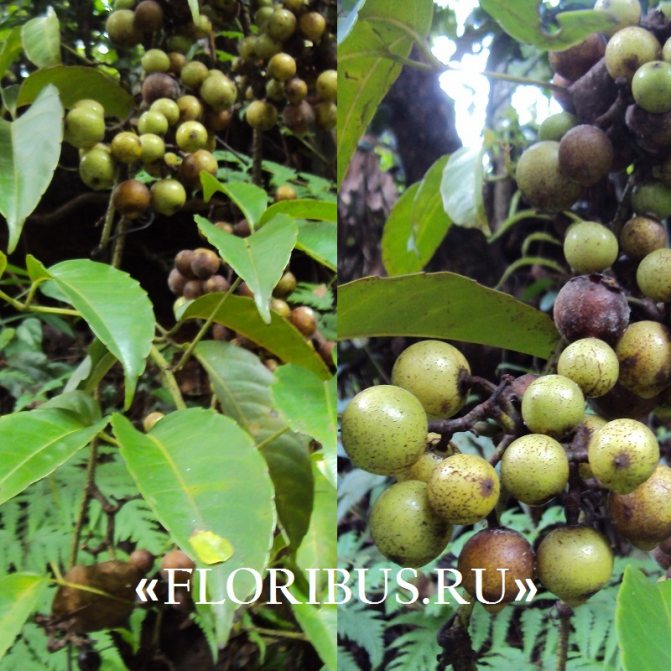

The easiest way to get a tetrastigma is to buy it. But, some growers use vegetative propagation methods to grow a few more plants, for example, to create a floral green background. Cuttings are cut at the beginning of active growth - in early spring. For rooting, apical cuts or young shoots of a plant (no older than 1 year old, which did not have time to woody), are suitable. Each cutting should have at least 1-2 leaves. The cut is made so that on the main stem, from where the branching leaves, 2-3 cm of the bare part of the cutting remains.
The cuttings will be rooted directly into the soil or in water. If you do this in a nutrient medium, then use light fertile mixtures (for example, based on peat with the addition of sand). The cutting is deepened by 3-5 cm. Its top should protrude above the ground level, otherwise the cutting will simply rot.The optimum temperature for rooting is + 22-25 degrees. For the first week, planting is placed in a greenhouse, airing it daily for several hours and watering it. After the plant has been taken out of the mini-greenhouse, it can be adapted to growth in indoor conditions, gradually accustoming it to the regularity of watering and usually the temperature.
Some problems can arise when rooting the cutting in water. During this procedure, flower growers are faced with the problem that the turgor of the leaves disappears from the plant. In this case, experienced plant breeders recommend leaving the stalk to “swim” in warm water for a day and not remove the transparent cap from it until the roots appear.
Another way is to breed new tetrastigmas with layering. They take a young shoot and drop it in a new pot or in the same one where the mother's vine grows. After 6-9 months, the shoot will acquire its powerful root system. As soon as this happens, the new plant is separated from the mother bush with a sharp knife, the cut is processed and looked after as an adult.
